Site Menu:
| This is an archived Horseadvice.com Discussion. The parent article and menus are available on the navigation menu below: |
| HorseAdvice.com » Diseases of Horses » Endocrine System » Equine Metabolic SynDrOme and Insulin Resistance » |
| Discussion on EMS and the stressed grass/no clover experiment | |
| Author | Message |
| Member: scooter |
Posted on Friday, Jul 3, 2009 - 6:52 pm: Well I have to try this just for the fact I am curious and have never figured out which is better.Tall non-stressed grass(supposedly less sugar, BUT can eat way more..tho didn't seem to be pigs on it) OR grazed to the ground stressed grass with tons of clover  (They never bring their heads up and act like they are starved) PATTY (They never bring their heads up and act like they are starved) PATTY The 2 geldings were weighed Hank #952's I took Hanks neck measurements last night so have that. Sam #747. I let them in the tall grass pen for a couple hours today. My observation was they don't eat that stuff nearly as fast, like every mouthful may be their last. When on the "stressed pasture" their heads NEVER come up. I am going to keep them on the same rations, including the Gro N win and see what happens! Here's a pic of what they have been eating 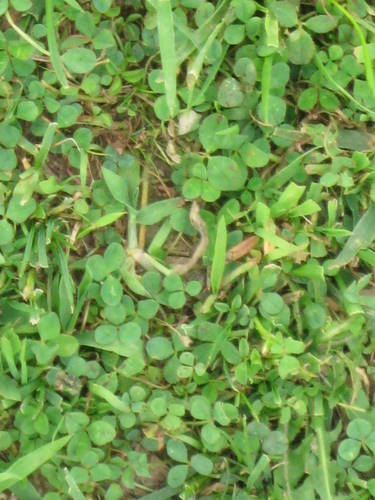 Here's a pic of their new pen's grass 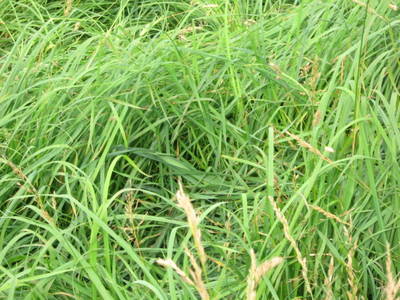 Here's a pic of their pasture that I just sprayed to kill the clover (Does anyone know if that is white clover OR alsike??) It appears to be both to me) 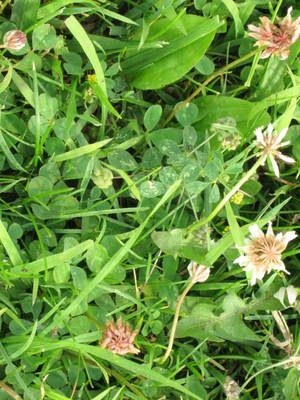 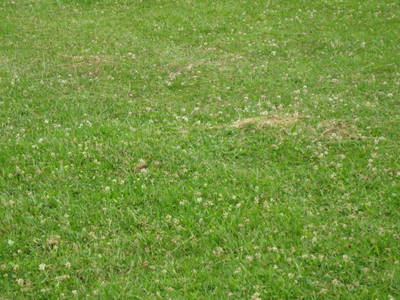
|
| Member: leslie1 |
Posted on Friday, Jul 3, 2009 - 8:14 pm: https://www.agf.gov.bc.ca/forage/alsike/alsike.htmHas a good visual pic of the differences. L |
| Member: rtrotter |
Posted on Friday, Jul 3, 2009 - 9:10 pm: Diane,The best I can determine, the biggest difference between alsike clover and red and or white clover is that it has no white on the clover leaf and the clover leaf stem and the flower leaf stem commence from the same point. As far as why your horses "do not come up for air" on the stressed grasses. Even though I'm not a horse I can certainly relate to the sugar high they get. I know when I eat any type of sugar especially if I start out in the morning with any kind of sugar, I can't control my eating for the rest of the day, I am constantly hungry. However, there are certain things I can eat that even though they have carbohydrates in them ( such as fruit or oatmeal) do not make me crazy the rest of the day for food. Perhaps the same mechanism is at work in horses too. The sugar in the grass is addicting to them and they can't get enough. High grass that is not stressed has much less sugar, so the eating binge is stopped before it begins. Rachelle |
| Member: ajudson1 |
Posted on Friday, Jul 3, 2009 - 11:14 pm: I thought I just read something about horses should only eat the top part of tall grass, all the sugar is in the bottom 4"?Prior to this summer, I never EVER had grass get higher than 4-5 inches! This summer I still have one pasture untouched, with timothy and other grasses going to seed actually! I have 4 horses, and about 3 acres, normally I am considering fencing in the lawn for extra pasture! After I read that, I changed the grazing from letting them eat the short stuff all day, and then moving the temp fence back every evening to the "New tall grass" to now they just get 3 hours every morning on the tall stuff, then back in the dirt area. I've been giving a tiny bit of hay mid day with their supps, then a flake each at night. Of course then I read about how bad it is to let horses go long periods without grazing, or having hay to digest. I am thinking the tall grass is like us eating a salad; you can't just chew twice and swallow. The clover is more like popcorn, you can just keep eating and it melts in your mouth. Plus you can eat lots of it! Or maybe like mini marshmallows? LOL! BTW, Diane, and everyone, just curious: Have you ever taped a horse for weight, and then taped again with a different weight tape and got 2 different answers?! I wonder if the one tape being newer, is more up to date on what they now think a horses weight is using one? Very weird; Tango went from about 1400 to 1285 I think it was. |
| Member: scooter |
Posted on Friday, Jul 3, 2009 - 11:33 pm: YES to the weight tape My paper one broke a few years ago, then got a new plastic one...they lost alot of weight when I switched to the plastic one My paper one broke a few years ago, then got a new plastic one...they lost alot of weight when I switched to the plastic one . I knew they were still the same fatness so just went from there as far a weight loss. . I knew they were still the same fatness so just went from there as far a weight loss.
|
| Member: scooter |
Posted on Saturday, Jul 4, 2009 - 7:10 am: Angie, I read that a few years ago, tho it seemed my horses gained weight easily on the taller grass also, altho taller was 2-3 inches, not TALL like in my pic. I have many different pastures available to me to try. I have never tried to let them out in pasture that is like the one I am now. They will be monitored VERY closely. On this "stressed" pasture Hank and Sam have had a "sub clinical" DP more often then not. I will be curious if this goes away. |
| Member: scooter |
Posted on Saturday, Jul 4, 2009 - 2:56 pm: Ok so our 4th has been rained out, and I am on a quest to end this constant state of IR in my horses.So once again this will probably be long  but things are starting to jive in my brain here. but things are starting to jive in my brain here. The geldings symptoms include fat pads, almost ALWAYS an increased digital pulse, VERY prone to founder if not "starved" Getting as much fat off them as I can has helped tremendously, YET they are still not thin I would put them at a 6-7 bsc. with 6#'s of hay a day, NO grain, and what was 1 handful of alfalfa pellets twice a day, which I have switched to 1# of a ration balancer. Hank gets exercised 5 days a week if weather permits...so can vary. Their dry lot has clover that keeps emerging and they suck on that all day. Which brings me to 2 years ago when he had that bad founder, I thought he was "dry lotted" but those ever emerging clover leafs were coming through continuously. We could not get his founder to stop, the vet came out and said to put him in the paddock...no "dry lot". WHY, he said those little sprigs of clover and grass were keeping him in a constant state of founder. I really had a hard time believing this, as it was so close to the ground I couldn't believe he would be getting much. I did paddock him and his recovery began, the weight started coming off and we made it through! Here is a pic of the "dry lot" when he was foundering I still "starve" them BUT they are in the "dry lot" with that clover. Their "horse pasture" is 70% clover at the minimum. Here is a pic of their "dry lot" when he was foundering see how he is sucking the sprigs of clover and grass. cresty neck ect. 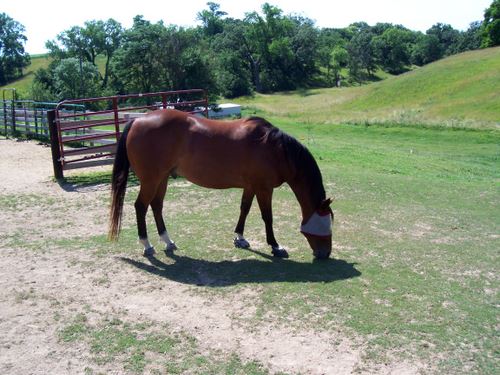 Here is a pic of him during Paddock and nothing but stemmy grass hay. Cresty neck is about gone  and has never been that small again! and has never been that small again! 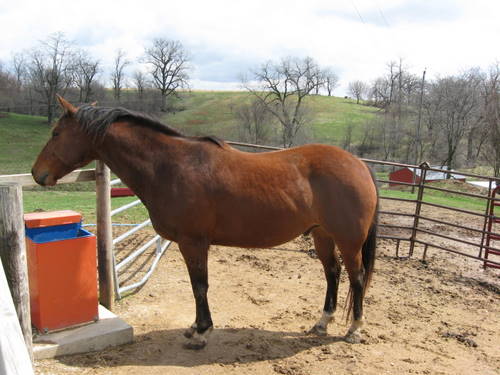 So what is a person to do with these type of horses? Paddock and starve them to death?? Turn them out and risk founder??? A little bit of both and cross your fingers?? (which is what I have been doing.) Though now that this clover thing has come together in my brain I am hoping eliminating that and stressed grass might do it. Though I do believe the clover to be more of the culprit. Here is a study about IR https://jn.nutrition.org/cgi/content/full/136/7/2090S Here is a paragraph from it The main initiating causes of laminitis identified are pasture composition (mainly grass fructan and clover starch), which accounts for 54%; digestive problems, associated mainly with excessive grain intake, yield another 8% (16). Laminitis is reported by 13% of all horse operations annually, ~30% of large operations. It is the disease most in need of research according to a recent survey of equine veterinarians In our pony study, pasture starch content increased from 4 to 8% of dry matter from March to May (6). Mean pasture height increased from ~5 to 15 cm. Clover proliferated, and it is consumed by ponies in preference to grass. It is likely, therefore, that starch intake increased much more than starch concentration, which doubled. These observations may reveal nutritional correlations between pasture composition and equine metabolism that will suggest countermeasures suitable for testing. Interesting read for those of you with IR horses especially those prone to founder. AND Scientific  I am hoping getting their nutrition on the right plane with the ration balancer, AND eliminating that darn clover that maybe they can live semi-normal horse lives with not quite as much stress! OF course none of this research is new, many questions have been asked regarding tall grass and short grass even here on this forum. I have read 100's of studies on this. My mistake has been thinking that since it is so short they couldn't have been getting much has been way off base I think. I do believe they will always have to be monitored closely, but am hoping against hope that this complete change in management may help US live a more normal life. As many of you know I check my horses DP morning and night...just habit anymore  Last night Sam's was absent, Hanks was definitely there. This morning Sam still quiet...Hanks quieter....this afternoon Hanks is GONE. I hope it stays GONE along with the evil clover! Happy 4th! |
| Member: erika |
Posted on Saturday, Jul 4, 2009 - 11:14 pm: Oh boy, Diane, it is a struggle to keep modern beings svelte isn't it?I tend to agree with Dr O's article where it says that overweight is the biggest culprit for founder, and I have finally gotten Sugar down to about a 4 on the body condition scale (yes, she is quite ribby) and no problems since! I would destroy the cover, and feed nothing but stemmy hay if I were wrestling with Hank's issues, Seems cruel, but I too am an "easy keeper" and if I can deal, I figure the horse can, too!  Good luck! Erika |
| Member: scooter |
Posted on Sunday, Jul 5, 2009 - 12:00 am: Agreed Erika, I haven't had a founder problem since Hanks weight watchers diet, Tho quite a battle that is growing tiresome and expensive Buying bedding for the lean-to, buying hay when there is 40 acres of grass, getting home from work and cleaning said expensive bedding, paddocks, leaving very little energy for riding or "house stuff" I literally walk at least 10 -15 miles a day...fast., and drive at the minimum 100 miles per day....I'm getting old!! I want to make my life easier!  If I recall Sugar is being helped along with pergolide. I am actually of the opinion (we'll see) that I can keep their weight down and avoid founder if kept in the right "conditions" I'm willing to give it a try anyway  At this point drugs are at the bottom of my list along with locking them in a small paddock with stemmy hay the rest of their lives. They would deal with it, but it is not how horses should live IMHO. and theirs!  In the end I will do what is healthiest for them, Physically anyway, I sure would like to keep them and me mentally happy too tho. I left them in the tall grass for 2 hrs. this morning and 2 hrs. this afternoon and they were happy, and not hogs at all, for the first time I can remember, their heads actually came up and they looked relaxed grazing. Hank even quit eating for awhile and took a nap. Hank in the tall grass https://s158.photobucket.com/albums/t90/scooter_098/?action=view¤t=pigseati ng005.flv In comparison... Flash in the yard with the clover, her mouth never stopped, she looked obsessed, just as the boys do when on clover. https://s158.photobucket.com/albums/t90/scooter_098/?action=view¤t=pigseati ng001.flv |
| Member: ajudson1 |
Posted on Sunday, Jul 5, 2009 - 1:57 pm: This is an interesting article regarding growing conditions, harvesting, and testing of hays and pastures. What I found interesting was the difference in test results based on how/when the grass hay was cut, and HOW the test sample was shipped to be tested! Frozen, not frozen, somewhat on ice, etc.And O.k, now we have to moniter cloudy days, sunny days, frost, content of fertilizer in the ground too??? I want my barely-there-never-enough-grass-to-eat pastures back!!!  https://www.thehorse.com/ViewArticle.aspx?ID=9587 |
| Member: scooter |
Posted on Sunday, Jul 5, 2009 - 2:52 pm: TOO much info isn't it! I think probably horses that aren't prone to founder or IR can be kept just about anywhere. I never worried about it when they were on the east side of town. They stayed on that year round with no problems at all...it had very little clover if any. I actually had them on a couple hundred acres for about 6 mos for the spring and summer mos. no problems except having a hard time finding them sometimes! except having a hard time finding them sometimes! I really am starting to think that starchy clover is a big part of my problem the more I think about it. I have one side of the horse pasture cleared of it! It even looks like a horse could graze in there...not so lush. I am going to let the grass grow up in there for a month or so before I use it...I THINK this is going to work! I also want to fertilize it with nitrogen to keep the clover GONE. After reading that white clover can affect their thyroid too...it really makes me wonder! Hanks and Sams DP remains Gone since I removed them from any type of clover. Hanks neck appears to be continuing to get smaller. I am letting the gate open to the tall pasture as they are not pigs on it so they can graze as they like....granted the pen isn't very big right now. I wonder if all this clover on the west side of town is what finally made them IR...I have a sneaking suspicion it is. With their ration balancer, and the tall grass I wonder if it will finally be possible to "keep" my horses more normally that would be so wonderful! |
| Member: leslie1 |
Posted on Sunday, Jul 5, 2009 - 7:09 pm: Man, I so feel for you. Having laminitis prone horses around that pasture has got to cause sleepless nights. I hope you find a way to make things work. (I am sure you will) I think Hanks neck look less cersty. And no DPs and mare sweating, well, you may be on to something.I am fortunate as my pastures are completely covered in clover, but my guys are doing great--so far...knock on wood. I can only wonder if its because Pumpkins only been here a year. She is keeping in good body weight.( she is ribby, considered at a 4, confirmed by vet  I know its hard for us owners to have a factual eye for the fat so I asked him) I know its hard for us owners to have a factual eye for the fat so I asked him) I am hoping Lara (Irish) is a natural born clover eater and so genetically capable of handleing it!! LOL----yeah...I know, but one can hope, right? |
| Member: scooter |
Posted on Sunday, Jul 5, 2009 - 8:38 pm: Well after 3 days of no stressed stuff in their diet and their ration balancer continues, Hank lost another inch on the circumference of his neck..his weight is still the same tho. He is NOT fat I can see some of his ribs and feel them all easily.. He just has had an IR look about him and those crazy DP's that even the vet was worried about, so they weren't nothing to sneeze about . . They remain gone, Sam and Hank have been in the tall grass the last 3 days. I will say they can still get at a very small patch of clover 10x10 that I can't do nothing about at this point. They seem to be leaving it alone anyway  Something new has been added other than the eye quit running, the mare sweating...Sam is starting to shed the long hair that I didn't get shaved, he has never done this before...it is coming out a lot.  Hanks neck 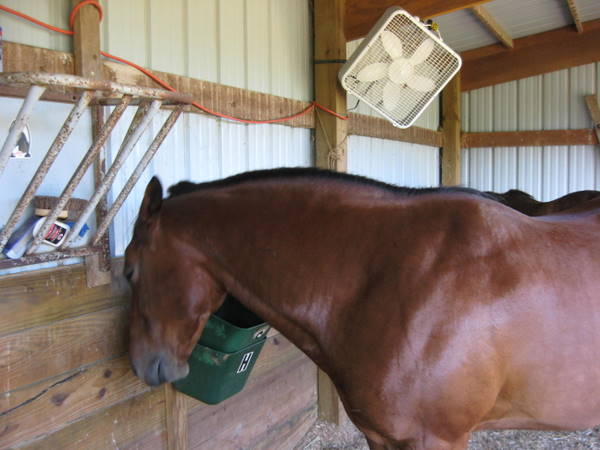 Hanks body condition...really he is not fat... 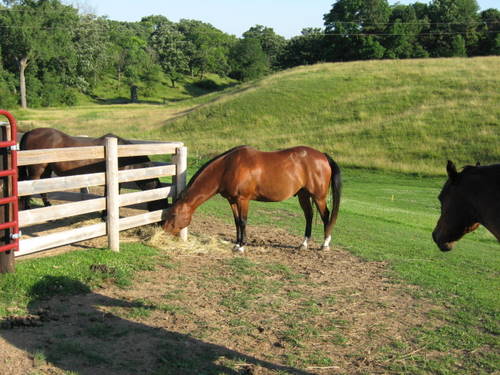 Sam shedding excuse the shave job  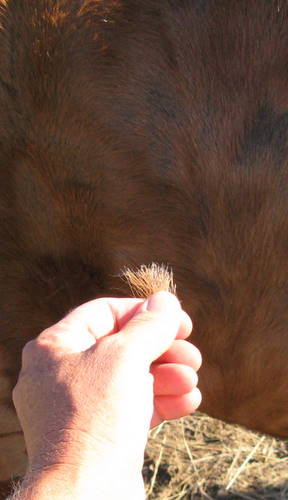
|
| Member: jowidner |
Posted on Sunday, Jul 5, 2009 - 10:38 pm: Hi Diane, I just read your thread and boy can I relate! After Suzy foundered last winter I decided that I would not pasture her at all this summer - dry lot only. Then last week she was lame and her right front was warm. Shoot! After reading your post, I think that it may be the grass that has been creeping in to her dry lot.I really understand about the extra cost and labor involved in managing an IR horse. I am purchasing more bedding and hay than ever before, not to mention the extra stall duty. I just ordered my hay for the winter, and even though its a bit less expensive this year, Ouch! it sure hits the budget hard. I too have a beautiful pasture that I cannot use. I could turn Gus out in it as he (so far) tolerates grass just fine. The only problem is he doesn't like to be out there by himself. So I can only turn him out for short stretches and it just isn't worth it. My husband has wanted to expand his garden into that space for a long time and this year I told him to go ahead, I couldn't use it anyway. Sigh. At least we will get some yummy sweet corn and winter squash out of the deal! Hank's coat looks great BTW! And that's very interesting about Sam's shedding. It makes sense to me though - as he's losing excess fat his metabolism is normalizing. After all, fat cells have strong endocrine effects. Here is Suzy in her dry lot, which you can see does have a lot of green. Too much!  She is an easy-keeping Morgan and its hard to keep her weight down. She always keeps her cresty neck, and at age 22, looks like she has a belly even when you can see her ribs. She is an easy-keeping Morgan and its hard to keep her weight down. She always keeps her cresty neck, and at age 22, looks like she has a belly even when you can see her ribs. 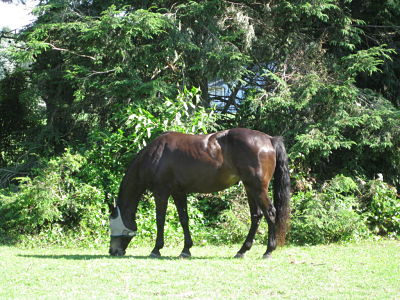
|
| Member: scooter |
Posted on Sunday, Jul 5, 2009 - 11:28 pm: Jo Ann she is a nice looking horse! It appears She has that weird back/side fat too? Hank is not fat either except in certain spots. I have been exercising him pretty regularly. Sam has not lost any weight...his diet has changed considerably tho! He now gets the ration balancer and no stressed grass OR clover. Much lower carb/starch load.Your dry lot isn't a dry lot either is it??  . I'm starting to wonder if these green dry lots aren't more of a problem then healthy tall grass. I always kind of liked the little bit of stuff that grows in the dry lot, it seemed to at least keep the horses "amused" and I didn't feel so guilty for "starving" them. . I'm starting to wonder if these green dry lots aren't more of a problem then healthy tall grass. I always kind of liked the little bit of stuff that grows in the dry lot, it seemed to at least keep the horses "amused" and I didn't feel so guilty for "starving" them. I am going to try to grow some "healthy" grass, get rid of the clover and hope the horses can graze at least 12 hrs. a day...worked up to it of course, and monitored VERY closely. My "healthy" pasture won't be ready for a few mos. but I have others available that they can go out on in the mean time, which should at least give me an idea if they can tolerate "healthy" tall grass. If not I guess the heifers will be glad to eat it and I wasted a bunch of time killing the clover, when I should have been cleaning! Does your "dry lot" have tiny clover leafs in it? |
| Member: jowidner |
Posted on Monday, Jul 6, 2009 - 12:21 am: Yes, she does have some weird lumpy fat. Suzy and I have a lot in common: easy keepers, not so young anymore, weird lumpy fat... Here is a pic from 2006. She is at a good weight and you can see her pretty face as she models her bitless bridle.  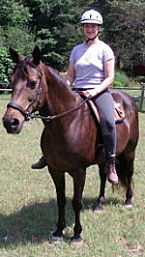 I don't think that there is any clover in her paddock but I am going to check it out tomorrow. |
| Member: scooter |
Posted on Monday, Jul 6, 2009 - 7:48 am: Jo Ann when did she founder? Do you know the reason why she foundered? I LOVE my bitless bridle more every day!Thanks |
| Member: ajudson1 |
Posted on Monday, Jul 6, 2009 - 8:57 am: As a self taught trimmer, and one who is struggling with nagging little issues, hoof wise/slight lameness, etc., with at least one of my horses at any given time, I always reading and rereading about barefoot natural hoof care.The paragraph I am going to paste here is from Pete Ramey's site, www.hoofrehab.com the article is "Heel Height: The Deciding Factor" Make special note of the sentence of why the fronts are more likely to founder and/or develope navicular. "When a foal is born, all four feet are the EXACT same microscopically (according to Dr. Bowker). The dramatically greater work load of the foal’s hind feet allow for much more natural development in the back of the hoof. By the time most domestic horses reach adult weight, they have all the right stuff in the hinds, and incomplete development of the fronts. This, of course, leads to sensitive front feet and is also the ONLY reason the fronts are more susceptible to founder and navicular disease than the hinds. (Aside from improper trimming/shoeing) So in other words, without changing anything in an individual horse’s lifestyle, diet or terrain, the fronts could be just as healthy as the hinds if only there was more frog pressure every day; more work; more stimulation and more hoof flexion. [Foals raised under routine, competent natural hoof care do consistently develop proper structure of their front feet, though, so a large part of this is simply the tradition of allowing foal hooves to overgrow, lifting the living foot out of function, and to then shoe them before the development of the foot is complete. I should point out here that when the foot is allowed to develop properly and the foals weight hasn't fallen behind its inner structure development, the result will be frogs that actually protrude longer than the heels; yearning to absorb more energy. Don't fight this; it's a good thing!" Read the whole article of course to really understand what he is saying, but I keep thinking how much so many average regular farriers are not understanding. It does seem backwards. Can't say I got my head wrapped around it totally either yet. Anyhow, just thought it was interesting with regards to founder. Remember, for years the method for foundered horses was to keep the heels HIGH! And special shoes. Of special note to you Diane, if you read the article, notice he says there are NOT sensitive soles for the most part. BTW, Diane, I could have added this to ANY of your threads about Hank, lol!! |
| Member: canter |
Posted on Monday, Jul 6, 2009 - 10:00 am: Angie, I'm having trouble understanding this. He says that foals have a greater workload on the rear feet, thus the feet develop better (major paraphrasing here)...what I don't understand is this: it's common knowledge that a horse will naturally carry more weight on the forehand. Foals will frequently play and rear, but I would think this is not more than 50% of the time, so even foals will naturally carry more weight in front (particularly since they grow so "down hill" until they mature). So if the theory is correct, then wouldn't a horse's FRONT feet naturally be more healthy/correct?It's only with work/training that we teach a horse to gradually take more weight behind and lighten the forehand (I know they have moments of lightness on their own). What did I miss or what am I not understanding here? |
| Member: mrose |
Posted on Monday, Jul 6, 2009 - 11:14 am: I'm going to have to read the entire article when I can sit down and take the time to really read and understand what is being said. The paragraph above doesn't make sense to me either.As Fran said, we spend so much of our training trying to get the horse to work off the hind end, get more under themselves, etc. A horse's natural center of gravity is in the area of the whithers, and most of their weight is carried on the front end; it is the front end that takes the most "pounding." Unless, everything I've read, observed, and been taught over the last 60 years is wrong. There must be something I'm missing here. One thing I DO agree on is the clover. Clover is a legume, related to alfalfa. I hate it in my pastures and try to eradicate it when I find it, although we do still have a little. It's great for cows and for growing foals or lactating mares, but mature horses that aren't working hard need to be kept off of it imo. We've had so much rain this year, plus I have fewer horses than ever, so our grass is very high. I love it! I worry less about the horses eating it and can keep them out for longer stretches at a time. I even have to supplement the old mare and stallion when they are on it. (They both get Eq. Senior) Everyone else seems to do good. In past years, and earlier this year, I was terrified to leave the horses out for more than a few hours a day. Interesting discussion! And, Hank is looking great! Koodos to you, Diane! JoAnn, I love your mare. She is lovely. I'll bet she was a "knock-out" when young! She's great looking now. Dr.O, anyone....like Diane's mare, my old mare also shows ribs although she looks good otherwise. This is the first year she's done this. She gets Eq. Senior plus free choice grass/grass hay. She is 28 this year. Is it possible to keep her from looking ribby? Or do all older horses look this way? |
| Member: rtrotter |
Posted on Monday, Jul 6, 2009 - 11:36 am: Fran, Angie,I am not sure if I can generalize this, but I think I understand why this might be so. A horse's motor is in his hind end this is where his power comes from therefore it makes sense that his hind feet would become stronger and more developed earlier in the maturation process. A horses hind end seems to stay on the ground and have more ground contact than its front end. We look for horses that are light in front and have an easy way of going, but maybe this is detrimental in a young horse who's front feet have not had the benefit of harder work. I kept shoes off my first youngster (Now three) until he had trained down to 2:25. I used a very competent DAEP trimmer. His gait was flawless, his feet developed properly. He could have crushed concrete with those feet. In hindsight I should have just left him alone and continued to train him barefoot ( I will do so with his younger brother) but other people convinced me that he needed shoes to race with, so I gave in. I shouldn't have, but I did. I believe that his attitude changed the minute I put those shoes on and while he did make it to the races, he was a very unhappy horse while doing it. His brother will remain barefoot for as long as reasonably possible. Rachelle |
| Member: ajudson1 |
Posted on Monday, Jul 6, 2009 - 12:30 pm: Hmmm...I think a horse must carry his weight equally at rest, and grazing. During movement, weight adjusts according to the gait; probably shifting to the rear only at the canter. I think, IMO, that we get the idea that the horse is heavier on the front because we see the head/neck weight, head down grazing. And we see a rider sitting on a horse. Which isn't natural.With movement, we probably equalize things. And most of our horses don't have acres and acres to move on. I guess I've never understood this concept of more weight on the forehand; If that were so, wouldn't those hoofs be bigger? The front legs bigger? The horse tipping over on his nose??  I have Pete's DVD's ordered. I hope he addresses this with up to date findings in regards to the founder/hoof trimming methods. He always says he's learning, and has changed some of what he used to say and do. It's interesting to say the least! If we all could let our horses graze 24/7, not worry about any hoof related problems, all because of the trimming method, and lots of movement. It sounds like many do this, but we are lacking standards for what works 100% of the time. |
| Member: mrose |
Posted on Monday, Jul 6, 2009 - 5:06 pm: Horses' front and rear feet are shaped differently. The front are normally a little larger and more round, with the backs being a little more narrow and oval. At least this is true of every horse I've owned. I wonder if this has anything to do with "anything?" |
| Member: scooter |
Posted on Monday, Jul 6, 2009 - 6:06 pm: Thanks for the Article Angie, the only problem with this concerning Hank anyway was he was let to be a foal, he was out 24/7 with the "herd" he was even born out in the pasture . . Sara, the farrier told me the back hooves are shaped the way they are for "digging in" going up hills ect. I had that GREAT barefoot trimmer at the time, and Hank was trimmed every 6-8 weeks right along with the adults. That farrier was always preaching about high heels, he kept my horses feet in wonderful condition, people would even ask who was trimming them they were so impressed! Hank has a big, plump healthy frog whether he is shod or not....always has. I DO agree that poor trimming can make horses that founder way worse or can contribute to it...been there done that! Even tho Hank was raised in ideal pasture conditions as far as movement, and hardness, his sole is thin, always has been. Actually as far as he is concerned I think taking the shoes off in riding season could lead to a "road founder" very easily. Since I have stopped trying to leave him barefoot (which even the natural trimmer couldn't accomplish) I have no trouble with bruising or tenderness...which can lead to a cranky Hank! He is the only horse I have owned that HAS to be shod for riding, and I have owned quite a few through the years. Now I can maybe buy into all the sugars he has been on since he hit the ground could have led to poor soles or something, but I don't think it was the way he was raised or trimmed as a young one anyway. I had the "natural" trimmer until he was 4 yo. Like you say tho if horses that are prone to founder are trimmed wrong it could upset the apple cart I'm sure! Sara glad to hear that about your horses being able to graze in tall grass, minus the clover. I hope this works for me. That clover is HARD to kill! I tried 2-4d hubby said it would work...it did kill the alsike clover, but the white clover remained looking VERY healthy! So I did a little research on what kills white clover and sprayed it AGAIN yesterday! I hope this works the grass will be dead from all the spraying pretty soon! Good hoof form and proper diet is what I am striving for  . There is also research that suggests high sugar diets keep the WL widened and possibly some horses in a constant state of mild laminitis...I suspect that with Hank, he stays sub clinical for the most part but it is there. My farrier is well aware one short trim, too much sole removal and he has a "flare up" MAYBE removing these sugars will help us to get that WL tightened up. I am not ruling out he will never be able to be ridden barefoot, but for now it is important. He is barefoot in the months I don't ride, sometimes struggles with hard, irregular, frozen ground, but for the most part can handle it. I suppose genetics come into play also...his mother has the best hooves I have seen as far as hardness and gravel crunching. His sire I don't know for sure, but he was 1/2 TB. . There is also research that suggests high sugar diets keep the WL widened and possibly some horses in a constant state of mild laminitis...I suspect that with Hank, he stays sub clinical for the most part but it is there. My farrier is well aware one short trim, too much sole removal and he has a "flare up" MAYBE removing these sugars will help us to get that WL tightened up. I am not ruling out he will never be able to be ridden barefoot, but for now it is important. He is barefoot in the months I don't ride, sometimes struggles with hard, irregular, frozen ground, but for the most part can handle it. I suppose genetics come into play also...his mother has the best hooves I have seen as far as hardness and gravel crunching. His sire I don't know for sure, but he was 1/2 TB. I have had horses with good hooves founder  and horses with crappy feet not founder!, so that is not the whole equation IMHO, but could definitely play a role amongst other things. and horses with crappy feet not founder!, so that is not the whole equation IMHO, but could definitely play a role amongst other things.
|
| Member: ajudson1 |
Posted on Monday, Jul 6, 2009 - 6:41 pm: And so it goes.... 'Nways, Diane, what did you spray with this time? We were going to pick up some 2-4D tomorrow. I let the horses in the tallest grass today for 3 hours. Found that they had ate nice areas down to the ground...guess what they were eating?? I didn't plant white clover either, I did do frost seeding of the red (Never again) and I don't see any of the red, just the white like you are finding! We've sprayed once this year with the 2-4d. |
| Member: scooter |
Posted on Monday, Jul 6, 2009 - 8:44 pm: I used weed b-gone Max yesterday, I'm not sure if it worked yet or not...all the clover heads are shriveled and gone...but the leafs are as green as ever yet I should know tomorrow if it worked. I should know tomorrow if it worked.
|
| Member: paul303 |
Posted on Tuesday, Jul 7, 2009 - 12:31 am: Good luck, guys. I did the Alsike clover discussion concerning the damage it did to my horse's legs ( photosensitivity ). I'm finding right now, that ANY exposure to the sun is too much for 2 of my horses' back legs. They remain in shipping boots from early morning 'til after 6PM. As long as the legs are protected from the sun, they continue to improve ( with no other treatment but the boots ). They are also exposed to NO CLOVER.My pasture is closed, and although treated twice by professionals, the Alsike continues to break through. That stuff is impossible. If Ortho-Max sprayed daily for the next few days doesn't eradicate what is left.....I swear, I'm going to dig it out by hand. If that doesn't work, then the next trick is GASOLINE....and keep the pasture closed! I've HAD it, I've HAD it, I've had had had it....I've officially gone "round the bend"!! |
| Member: scooter |
Posted on Tuesday, Jul 7, 2009 - 7:17 am: Lee . The 24-d (mixed rather strongly) . The 24-d (mixed rather strongly) killed my alsike very well it is all brown and crispy killed my alsike very well it is all brown and crispy . The white clover was still thriving as of yesterday! . The white clover was still thriving as of yesterday!
|
| Member: mrose |
Posted on Tuesday, Jul 7, 2009 - 10:28 am: One sure way to get rid of it all is to spray then plow the field, spray again, let it sit all winter then reseed in the spring. We did this to our grass hay field and it looks good now, with no clover. Don't know how long it will last this way, but it's great this summer. |
| Member: scooter |
Posted on Tuesday, Jul 7, 2009 - 4:34 pm: WOHOO Clover death! I still have some spots that the clover is not dead...not many, but I think that is because I missed it with the spray. I have been using the 4-wheeler sprayer and it is hand held, so I could have easily missed a little.The changes in the horses fat pads are very remarkable, Hanks rib/back fat has really shrunk! Sam's weird leg fat is very shrunken and I can only see one lump instead of 3 and he is still shedding, pulses remain gone even on 3-4 hrs. turnout on the "long grass" The top pics is the horse pasture I didn't spray yet, the bottom, the one I am working on.  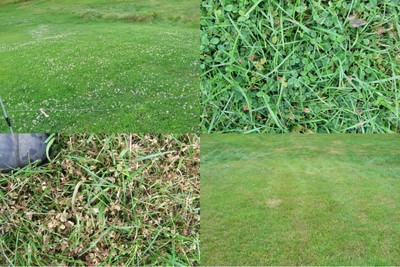
|
| Member: scooter |
Posted on Tuesday, Jul 7, 2009 - 4:48 pm: Sam's lumps 6-29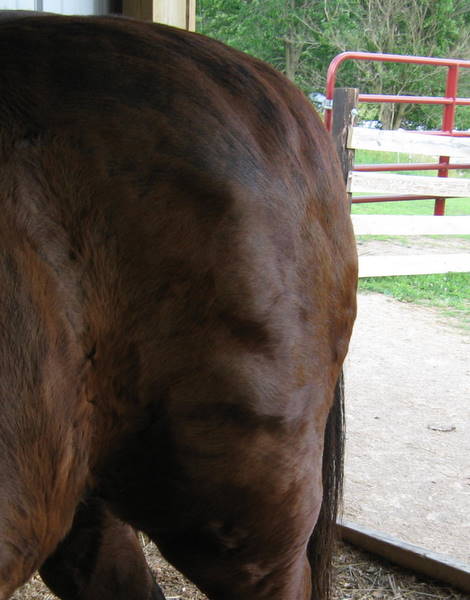 Sams lumps 7-7 If I wasn't so impressed with this you would not be seeing this shave job! 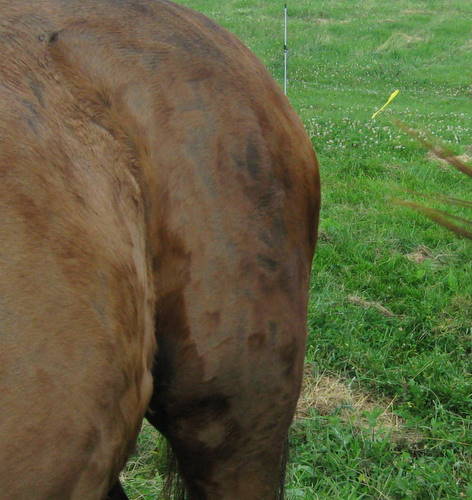 Unbloated Hank  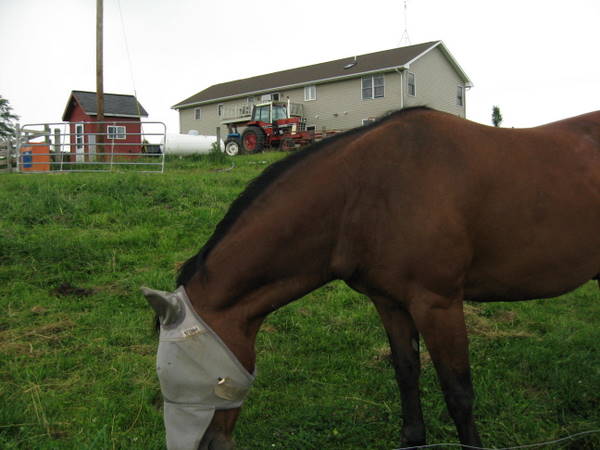
|
| Member: mrose |
Posted on Tuesday, Jul 7, 2009 - 5:28 pm: Boy! You DID have a lot of clover in that pasture! I've got to say, ol' Hank looks quite a bit better! Good for you. Don't worry about the clip job. I just did my old mare last night and my new blade quit working about a third of the way through, plus she'd rolled and got her neck dirty before I could get started on her. I'm NOT showing pictures! I'm glad she doesn't have a mirror. The other horses are all afraid of her, so they won't say a word about her new hair style. Good thing or she'd be really mad at me! Hope it grows out some before the clinic! |
| Member: jowidner |
Posted on Tuesday, Jul 7, 2009 - 5:43 pm: I wonder if there is a way to kill the clover without using herbicides? Probably no easy way at any rate. We've been doing our best to go "green" around here, but still use some chemicals. I am probably the worst offender by continuing to use fly spray on the horses.Last night hubby came in all dejected about some kind of insect eating our winter squash plants. I asked him if he would resort to using sevin, which I think of as being pretty mild, and he said, no he wants to continue with his organic practices. I hope we get some squash this year! Sara and Diane, thanks for your compliments about Suzy. She was quite stunning in her youth, but what I like best about here is that she is very, very clever. Sometimes a little too clever! She was bred to be a show horse, but she was trail ridden more than she was shown. While she was a spirited ride, she carried me and my friends safely through many dicey situations. Diane, the first founder happened while my friends were boarding her. I think she must have been ten. The barn owner was a newbie and didn't understand the importance of keeping the easy keepers at a healthy weight. Suzy blew up like a tick as we all know happens quickly with horses like Suzy and Hank. They corrected the situation, got her slimmed down, and she did quite well - very sound - for another four years or so. As she aged, she began getting sore from time to time and we did a complete lameness eval. There were several things that showed up in her Xrays -signs of rotation, ringbone, and some navicular. Yikes! We adjusted her trim and put her on Pergolide because she was beginning to show signs of Cushings. Again, she did well, but over the last three years she has been very difficult to manage and has had several more bouts of mild laminitis, culminating in a very bad bout last winter. I manage her carefully (according to Horseadvice guidelines) and my vet, who is a diplomate vet in internal medicine, says that we are doing everything right, and that she doesn't know of any better management plan for her beyond what we currently have in place. I keep looking for answers, and I have learned a lot from reading about Hank and others who have similar issues. Diane, you have no doubt educated a ton of us with your detailed posts! |
| Member: scooter |
Posted on Tuesday, Jul 7, 2009 - 7:00 pm: Thanks Jo Ann, These type of horses are in such sad situations, which is just as hard on the owner.They pretty much have to be starved, go through painful bouts of laminitis, and just LOOK unhealthy even if in good weight. I have been going by the book with my horses YET they still just don't look right, with those weird fat pads, ect. SOMETHING has got to be causing this and slowly through the years I am finding out the "triggers" which I am sure are probably different in different horses...tho common sense will say if they start looking "stupid" their DP's pick up, they seem to bloat, and their necks get hard and grow 3 ins. overnight something is going very wrong and whatever did it eliminate it, if you can figure out just what that was! They don't always play by the book, sometimes things you THINK shouldn't have done that...did it  . As in the "dry lot" sprigs of grass and clover. . As in the "dry lot" sprigs of grass and clover. Mine can not tolerate alfalfa...learned from a founder from Sam in the middle of winter, AND huge DP"S in Hank. I mistakenly gave them some hay with about 30% alfalfa this spring and found Sam foundering the next morning...C'mon don't seem right! I know some of my horses triggers...alfalfa seems to be a biggy, so I guess clover couldn't be a far reach considering it is a legume (I consider it a weed!) And I found out as I was reading about the high starch plants, that thistles are VERY high in sugar...mine love thistles they will clean a pasture of them...hubby likes that, I didn't think nothing of it, but after reading that it occured to me, after cleaning the pasture of thistles they walk funny LOL! Uh-duh! I've always suspected the clover they always look "bloated" when on it, but haven't been up to the task of eliminating it, because I wasn't sure. I have known clover hay "upsets" the apple cart too. That I don't get anymore! Winter stressed grass has brought on a founder in Hank when we didn't have snow to cover it HELLO Diane, What is the matter with me!!! So as I develop a learning curve here, I hope I can eliminate these triggers...that "normal" horses can tolerate! I have also been ignoring their nutrition I think. Starving them has got to equate to poor nutrition...that's where I hope this ration balancer will help me...I believe it is. I also believe once I get their bodies in better "form" so to speak and get rid of that IR look they will be able to handle grazing "healthy" grass. I'm glad Dr'O. has been tolerating me putting this stuff in here. I know it isn't all scientific based, but based on my experiences. Sometimes I'm right and sometimes I'm wrong...but I am determined at this point to return my horses to as normal of living conditions as possible...after all grass is their natural food and very healthy for them physically AND mentally, not the enemy. I really think at this point they will be able to graze "healthy grass" probably not 24/7 but at least enough of the day to make them "feel" normal. I have NO doubt that they already look 100% better with the removal of most of the clover from their diet(soon to be all) and the "stressed grass" These are my horses tho and doesn't mean it will work on all... Even tho they are the poster children for IR  . I do think the concept is basically the same remove as much sugar and starch as possible, figure out any "weird triggers" and we may have a fighting chance....I HOPE! . I do think the concept is basically the same remove as much sugar and starch as possible, figure out any "weird triggers" and we may have a fighting chance....I HOPE! You guys and Dr.O. are my "sounding board" in case I get out of line! and I appreciate that! My horsie friends have moved away, and non-horsie people could really care less 
|
| Member: scooter |
Posted on Friday, Jul 10, 2009 - 8:47 am: When the vet(s) were here for Hanks fetlock I told them what I was doing with my pasture. They both said it was a very good idea, as most of their IR/foundered horses are in clover covered pasture. Funny when I stopped at the office to make an appointment he said what's up...Hank came out of my mouth, and he didn't even let me finish and said he's foundering isn't he! YEEE of little faith, NO he's not...we are over that hump and it won't happen again even if I do have to starve him!I told them I really thought they could handle "normal" grass and he agreed readily, just to be careful and monitor them closely. He agreed Hank and Sam looked better, of course did his usual DP check which was "normal" for the 1st time since he started checking them. The"other" vet wanted to know what I used to kill it, they couldn't believe the difference in the 2 pastures. He said they actually had told other clients to do the same with their IR horses pasture. I told him I sprayed it with 24-D then Ortho max...still have to get the spots I missed so it will take 3 sprayings..he said at least I was determined! The horses do look much better, Sam especially, he was much more lumpier then Hank, his lumps have shrunk dramatically or disappeared. His bubble butt as I call it is almost normal...vet even commented on that. Hanks neck looks better also and continues to shrink. I was in process of weighing them when I saw Hanks fetlock so never got that done  I also told him about the ration balancer I had them on. Dan said he was the one that talked that feed store into carrying Buckeye stuff, why did he not tell me???? He said for IR horses he thought it was the best thing they could have for "feed" so they can get their minerals while being "starved" and is very low NSC's. BTW my horses love the stuff! And are still getting "tall" grass turnout for about 4 hrs. a day. Yesterday they actually left it and came in and took a nap after a couple hours, they don't even gobble up their supper hay anymore, just nibble and leave it for awhile. It is gone in the morning, but at least it doesn't disappear in 1/2 an hour. |
| Member: lilo |
Posted on Friday, Jul 10, 2009 - 10:32 am: Diane - it looks like you are making a lot of progress with your guys. Fortunately, I do not have clover in my pasture. I did have a little alfalfa at one time, but several years of draught took care of that.Lilo |
| Member: scooter |
Posted on Friday, Jul 10, 2009 - 8:23 pm: Well here is a collage of Hanks neck since starting the cresty neck experiment. I weighed him tonight and he has DrOpped 15-20lbs. He is getting the same rations as far as hay, the clover has been almost eliminated, about 4 hrs. grazing tall grass, 1lb of ration balancer. These 4 pics are taken about 5 days apart the last being tonight. 2 more in. has come of the CIRCUMFERENCE of his neck. His neck crest doesn't seem as thick and has definitely softened. It still has a ways to go, but does look much better. and so does he and so does he 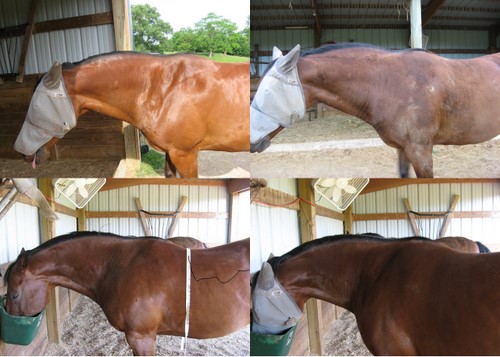
|
| Member: sodmonst |
Posted on Friday, Jul 10, 2009 - 11:12 pm: I don't understand "ration balancer." Is that explained somewhere? I cannot find it in a search. Hank's neck does look better to me too. He's so glossy! |
| Member: scooter |
Posted on Saturday, Jul 11, 2009 - 7:39 am: "They are generally forage-based, no grain pellets that are low in NSC and therefore safer to feed to horses that might be at risk for colic, laminitis, ulcers and other chronic digestive upset problems. They are nutrient dense and generally higher in most nutrients than most conventional feeds. But, they are more than just a vit/min supplement. They offer things like amino acids and prebiotics that are helpful in the digestion/utilization of other nutrients. They also generally contain some caloric value...around 1300 cal/lb....nearly that of some sweet feeds...but, of course, much less is fed."I am using Buckeyes gro n win, but if you google horse ration balancer you will find many exist. I am using the one for grass/grass hay.. but they also have them for alfalfa too. The one I am using https://www.buckeyenutrition.com/equine/GNW%20product%20manual.pdf |
| Member: scooter |
Posted on Saturday, Jul 11, 2009 - 8:32 am: BTW Purina also has a ration balancer Natures essentials 32 or 12 depending on if you feed grass or alfalfa. Most people have Purina available to them. Thought I would mention that for anyone that are interested in ration balancers.https://www.horse.purinamills.com/products/enrich%2012-32.asp |
| Member: ajudson1 |
Posted on Saturday, Jul 11, 2009 - 9:11 am: Diane,Just to clarify, you are feeding the ration balancer, and extra magnesium? And the ration balancer is because you are limiting hay/grass? I still have 5 bags of sho glow left, but have added the Quiessence to the geldings diet. Plus I have bucket of SE & E, so I have enough vitamins & minerals for a few months yet, feeding the SE & E in the summer, SG in the winter. I couldn't find a magnesium product here. We have Purina at the mill 25 miles from here; I can live with that drive. Thanks for info. |
| Member: lilo |
Posted on Saturday, Jul 11, 2009 - 9:56 am: Hi all - I have added Purina's Natures Essentials 32 to my feed regimen. My mare still receives some Equine Senior along with it, the gelding gets only the Natures Essentials - at a minimum dose. I have to weigh the rations to tell exactly what I am feeding.My vet uses it for his horses, and likes it. However, it is very expensive. I pay about $16.50 for a bag of Equine Senior, about $26 for the Natures Essentials 32 (formerly known as "Born to Win"). The Natures Essentials 32 has vitamins, minerals, and 32% protein. https://horse.purinamills.com/products/Enrich32.asp The link will proved more information. I have only started this since May. I can't say that the mare's crest is smaller - I posted a photo of her in Diane's Cresty Neck thread. Lilo |
| Member: scooter |
Posted on Saturday, Jul 11, 2009 - 12:38 pm: Yes Angie, I am adding mag ox to their rations, They are just getting the ration balancer otherwise. Fortunately I don't buy my other supplements in bulk, So they have been eliminated...except the mares joint supp. and I have added back Hanks hoof supp. now that I am controlling his mineral intake. He was a little too enthusiastic about the free choice minerals!! it did start to worry me he may overdose on something . . As you know MG. supplementation is controversial, and I probably don't need it. I bought a #50 bag of mag ox from the feed store...for cows, it was cheap...If I recall less then $20 and will last a year easily! Lilo is right, ration balancers are more expensive I believe the gro N win was around $25 for a 50# bag. The recommended dosage is about 1# per day for #1000 LB horse(that covers all their nutritional needs)with forage. My other 2 don't go 1000#'s so I can get away with less for them. I was able to eliminate their vit/min supplement, alfalfa pellets (for protein), and the safechoice(which they didn't get much of) so all in all I feel I am coming out ahead and their nutrition is more balanced for their meager diets. I also believe that eliminating the stressed grass/clover is probably MORE important in the change I am seeing, the ration balancer helps keep their nutrition on a healthy plane. Basically I am doing what Dr.O.'s article recommends for these type of horses, except I am trying to add a normal life to the equation, rather than "dry lot" and stemmy hay. I don't know if it is possible, so far so good  . The horse have not gained an ounce and as you can see from my post above Hank has DrOpped a little. He is not getting exercised because of his fetlock. Sam has also DrOpped about 20#'s and I don't really have them on a "diet" other than eliminating that clover and short grass! . The horse have not gained an ounce and as you can see from my post above Hank has DrOpped a little. He is not getting exercised because of his fetlock. Sam has also DrOpped about 20#'s and I don't really have them on a "diet" other than eliminating that clover and short grass! When I am home on the weekends I let the boys in the "tall" grass all day, they very rarely stay out there very long, they seem to act like horses should (another first!), rather than never coming up for a breath of air, they eat and nap, move around a bit ect. I think that clover and stressed grass is so full of "sugars" they can't hardly stand themselves  The first pasture I killed the clover in is now growing grass, at some point(probably this fall) I want to fertilize it with nitrogen to keep the clover surpressed and the grass healthy. I'm hoping in 2-3 weeks I will be able to let them use that side.  Today is the beginning of killing it on the other side! Today is the beginning of killing it on the other side! surprisingly enough...or not really surprising at all, hubby called me yesterday and said one of the neighbors saw one of the cows lying by itself and thought maybe he might want to check it. I went over to the farm they were at..where all my horses foundered the year I moved them to the west side of town. There they were in that small pasture that my horses LOVED! The guy came out that owns the place and asked me why they stay in that pasture so much. We have 20 cows in there and that area is about 1/4 of an acre! They love that clover pasture as much as the horses did. It appeared one of our cows was trying to founder..rare in cattle. except if they have grain overload. Interesting..cows got moved out of the clover pasture and she seems a little better today. My horse pastures are(were) just as full of clover as that one. The only difference is I haven't allowed free access to them since Hank foundered...Thankfully! Tho their dry lot is full of tiny leafs of it that they did continuously suck on...I have eliminated as much of that as possible for the time being, but they still have access to some. Hank has not had a palpable Digital pulse since then  even when in the tall grass. And none of that slobbering either! even when in the tall grass. And none of that slobbering either!
|
| Moderator: DrO |
Posted on Saturday, Jul 11, 2009 - 3:57 pm: Diane, dry lot and stemmy hay is what you go to when better hays fail which is what you go to when limited turn out on the pasture does not work. There is no doubt removing the clover will do wonders at reducing the caloric density of your pasture and making it a more reasonable alternative and this is all discussed at Horse Care » Equine Nutrition, Horse Feeds, Feeding » Fat or Obese Horse Nutrition.DrO |
| Member: scooter |
Posted on Saturday, Jul 11, 2009 - 4:44 pm: UMMM Dr.O. I can recite that article backwards....it is my bible for keeping these fat ponies , and thanks to it I have been able to manage the horses fairly well. , and thanks to it I have been able to manage the horses fairly well. I just haven't been able to put everything together in my brain, I've been doing things half A$$ed! I have wanted to get rid of all that clover since we moved here, but hubby said I was nuts and Blah blah blah  Now he just puts up with my silliness and let's me do what I want, so now I am getting rid of that irritating clover, before he starts paying attention to me again! He has even admitted the horses look better since I switched pastures and "feed". You see I didn't realize that even the dry lot seemed to be keeping Hank in a state of "chronic laminitis" I have mentioned many times how those DP's bother me, but it seemed we were doomed to have them forever and I had accepted that....didn't like it tho! They even bothered my vet...that's why he suggested the thyro-l for him. It would seem these type of horses do and can have different triggers...tho most are the same as stated in your article. I was surprised when I read how full of sugar thistles are, I should have known tho, my horses will seek them out to eat. First they paw them up and make them juicy then devour them. Thanks |
| Member: ajudson1 |
Posted on Saturday, Jul 11, 2009 - 8:18 pm: Diane,I just got done watching DVD 5 of Pete Ramey's "Under the Horse" series, and it was all about laminitis. Key points I wrote down: (which won't be new news to you) 1. horses don't need grain. 2. 24 hour a day access to pasture/hay with plenty of MOVEMENT. 3.Mineral deficiencies rare, but IMBALANCES very common, because we add supplements. 4. Test hay then add supps if needed. 5. Hay lacks fatty acids, vit E 6. Starving horses is worse than them eating an abundance. (the part about enzymes, the good guys and bad guys that screw up in the horses gut, cause inflammation...need to study that more...has to do with carb over load, inconsistent eating) 7. Sugar levels in grass build up during the sunny part of the day, highest at 4-5 pm. DrOp over night. 8. Sugar level can change 0-30% during the course of the day. 9. Pull horses off grass during high stressed times. DrOught, winter grasses. (most of this he says is from www.safergrass.org) He suggests Carb-X...ha, high mag and chromium supp! Bottom line: CAnnot fix a hoof that keeps flaring, having WLD, founder, etc., without addressing the diet, sugars, movment. But then we all know that , right? the part that scares me? Pete says most horses in are a laminitic state, and we never know it. By the time we feel a pounding pulse, damage is done. And sometimes we never notice that. In a laminitic state at just the micro level maybe...as I said , just watched this one once, got excited about what he was teaching! Oh, yes, better to eat 24/7 on the grown up pastures, with a grazing muzzle, then short turn outs during the day on shorter grasses. Gets complicated about sugar levels in hay....even stemmy hay? I REFUSE to think about that right now, brain overload. Sure you didn't watch these DVD's too? Thanks for info, and for getting me thinking about the whole subject. Don't have the problems YET, that Hank does, want to keep it that way. P.S., don't quiz me on this anyone! JFYI!!! |
| Member: scooter |
Posted on Saturday, Jul 11, 2009 - 10:15 pm: Well it sounds like I'm on the right track anyway . I think Hank has been in a constant state of laminitis and Sam too for a matter of fact. It would explain why we can not get his hooves under control. I'll be curious to see if they change over the next few months. I suspected that those constant DP's indicated some kind of inflammation was going on. . I think Hank has been in a constant state of laminitis and Sam too for a matter of fact. It would explain why we can not get his hooves under control. I'll be curious to see if they change over the next few months. I suspected that those constant DP's indicated some kind of inflammation was going on. My hay is in the barn, so testing it won't make a difference. Tho it did pass the horse test as far as low carb! I have some hay left from last year, that I had a feeling was a little "sugary" because they liked it too well! I have been giving them a leaf of "new" hay and a leaf of "old" hay they gobble up the old stuff and pick at the new stuff...perfect. I have found by observation I can almost pick out high sugar stuff if I pay attention..they always go after that stuff first, as in the thistles....I read about thistles on safegrass, which is a very good site. I am trying my hardest to return these horses to a more natural state, removing the clover is a first step, I think the ration balancer will help with the nutrients that grass/grass hay lacks and is a LOW carb addition. This is a totally new management change and it will be done slowly, but I have hope, it can't be any worse then being stuck in a dry lot with stemmy hay. Getting rid of the clover was my only chance of returning them to pasture. My pasture doesn't even look threatening anymore. It looks like the pasture I had on the east side of town. BTW I sprayed the other side of the pasture with a little stronger solution of 24-d this morning and it was brown tonight! Now I have to wait for a few good rains and try it out! I did research 24-d a little and it would seem it is a rather benign as far as herbicides go. I don't like using herbicides, but this is war if I have to pull that clover out by hand I will! I'll get this figured out yet! Thanks for the info sounds like interesting DVD's 
|
| Moderator: DrO |
Posted on Sunday, Jul 12, 2009 - 8:29 am: Though I have let the discussion ramble around a bit without critique I must make a few comments about the Ramey list:1)While horses don't require grain, often grain is a good way to meet a horse's need for energy when he exceeds that provided by the available forage. 5)Fatty acid deficiencies are not reported in the horse. 6)I don't find either under or over feeding horses desirable. There are other statements made here that are opinions and not scientifically supported fact. I recommend the articles on these subjects for more. Concerning the confusion over pasture grass induced founder I think the confusion comes mainly from a lack of understanding about the nature of insulin resistance and how it intertwines with the separate event of ingestion of the non digestible NSC's. For more on this see the causes section of Diseases of Horses » Lameness » Diseases of the Hoof » Founder & Laminitis » Forage (Spring and Fall Pasture) Associated Founder. Clover of all types should be sensitive to just about any broadleaf herbicide when applied according to instructions Diane and unlike some common large rooted weeds does not tend to just defoliate and return. DrO |
| Member: scooter |
Posted on Sunday, Jul 12, 2009 - 9:12 am: Thanks Dr.O. when I did the other side of the pasture with 24-d the white clover didn't even turn brown...used at suggested rates. Altho there is 2 types of 24-d I discovered, LV 400 and amine. I used amine the first time and this time I tried out the LV 400, maybe that was the difference?I too found #2 and #6 on Angies list hard to believe. If I left my horses out 24/7 on pasture I'm afraid I would have problems again, I am aiming for 6-12 hrs. hopefully  As far as free feeding that would be great, have tried that and it doesn't work for mine anyway. I'm not sure if that was addressed for IR types tho. Movement/exercise is key tho as we know. I guess the problem is when you have these types, unless they are carefully managed they are usually lame and exercise seems impossible. I have got over that hump, except now Hank has that fetlock  "starving" these type seems about the only thing that works, whether it is actually starving them I don't know. According to their weight it isn't, but it is a "weird" kind of fat they seem to accumulate even when in good weight that makes me wonder even when "starving" them if something is out of whack in their metabolism. I never had to "starve" any of my horses until these clover pastures came into the picture. I am hoping I have figured out MY horses triggers, and by removing most of them they can live semi-normal horse lives. Your Articles have been the saving grace for my fat horses, and how I have avoided founder the last 2 years. NOW I have to get my management up to par! BY nature I am a very curious person and have to try to figure out the WHYS of things. The list Angie made of Rameys comments are starting to be the way some people think, I don't think it is wrong, every horse is an individual and it does have to be applied appropiately, with careful management and observation. As we know what works for one doesn't always work for the other. My mare can eat clover and grass all day with no ill effect other than she gets fat. She has NEVER had so much as a abnormal DP or stretched WL... The geldings look at it or breathe the air and are foundering....wonder what the difference is? There has to be something different, and I would love to know what it is! |
| Member: ajudson1 |
Posted on Sunday, Jul 12, 2009 - 10:46 am: DrO, Diane,My "List" were my notes, taken as I watched the DVD. Ramey was going off of studies by I think, Bowker,(MI guy) and Polliet? Sorry, not 100% sure on names without the DVD running in front of me. As for 1. Yes he did say some horses need extra calories. Never from high sugar sweet feeds... And not all horses have problems. 2. Based on how horses were meant to graze, lots of movement, sparse grazing. He also make it clear that we don't, and probably never will, have ideal grazing conditions (I am paraphrasing! Don't attack the guy who made the DVD!) Native grasses would never hold up in our pastures. The tall grasses being safer, I guess if grazed in the early morning. QUESTION: Most years my pastures are grazed to the dirt, is that safe as far as low sugar? 5. I wasn't sure why the need for flax & E when feeding hay. If it was addressed, I missed it. maybe the next DVD explains it. 6. I don't like starving a horse, nor letting them graze 24/7 on lush pastures either. 24/7 on sparse pastures has always worked for me...this is the first year I've had more grass then horses to eat it. If I can understand what PR is saying in regards to how feeding in meals instead of constant nibbling causes the gut imbalances, inflammation, I'll add it here later. It was new to me. As for "opinions" it sure sounds to me like there are many knowledgeable people, with impressive back rounds (college degrees, life time studying this subject) doing their damnest to figure out how to prevent founder/laminitis. If I remember correctly, they did a control group of horses, feeding one group low carb/low sugar, and the other high sugar. It seems they found, by killing each horse at different times(?)that the changes to the laminie took place as soon as an hour after the high sugar meal. Long before the pounding pulse would be felt. One thing PR did say, was he thinks in the next 10 years, we will have a pretty good understanding of what is causing the problems, and how to prevent it. Then it will be scientific FACTS!  If anyone else owns these DVDS, and has anything to add on the Laminitis ones, please jump in. I am not promoting PR, I bought them to learn how to trim better, not realizing he went into much, much more as part of "hoof care." Peace everyone! "May the Hoof by with you!" (a sound, rock crushing hoof!) |
| Member: ekaufman |
Posted on Sunday, Jul 12, 2009 - 11:34 am: One comment on the 2,4-D. My understanding is that the LV product is designed to be more volatile, so as to mix better with other herbicides (if you're doing a homebrew). The amine is designed to be used on its own. What that means is that the LV is much more likely to do that unlovely 2,4-D thing and rise up in an herbicidal cloud and go settle on non-target broadleafs (such as trees, the neighbor's alfalfa etc.). If you use that version, apply it early so it can dry before the heat of the day, and doesn't go visiting.If your water is hard, both seem to perform better if you add some vinegar to the water. Anecdotally this also "cuts the wax" on the target leaves, but I believe it actually just corrects the Ph and allows the herbicide to function as it should. As for this and the related thread, well, I have a deep Yankee mistrust of a man who tries to tell me something and sell me something in the same paragraph. My best results with a range of horses has been with poor pasture, a trace mineral block, grass hay and hard work. I supplement those who seem under-nourished (or a broodmare when she needs copper etc.), but I absolutely can't get my mind around the idea of any mammal being obese because it is under-nourished. Just can't understand it. Guess I'll wait to see these things as facts. |
| Member: scooter |
Posted on Sunday, Jul 12, 2009 - 12:14 pm: Elizabeth I asked the farm store the difference in the 2 forms of 24-d and they didn't know...hubby didn't seem to either, so I researched it a little further and it would seem the LV has diesel mixed with it! Probably to make it stick better. We don't have any neighbors close enough to worry about drift.Unless you have owned one of these troublesome type of horses I have to admit wrapping your brain around it is hard I sure don't understand it! An obese animal OR human can be obese and undernourished...look around! It can be from metabolic upset...disease...or just plain poor diets or all of the above. I DO starve my horses unless you think 6-8lbs. of grass hay a day and literally a handful of alfalfa pellets(before I started my experiment) is a lot for a big built 15.1 hh horse, who SHOULD be healthy at 950-1000's. Not healthy, not a lot of exercise can be done, actually quite a vicious circle that I am trying to overcome. I don't have poor pasture available, I suppose different areas of the country do. This lovely midwest is "blessed" with great "cow" pastures, and is VERY green and abundant apr.-Nov. Many horses live just fine on this, yet quite a few don't what's the difference??? I see backyard horses fatter than Hank, who do nothing, never founder. I even called my vet one day and asked him why that was when Hank was in his dry lot foundering. Retrospect would have it that all those horses I saw were in big fields filled with grass up to their chests. I don't know if Hank can live that way, but I certainly see no harm in giving it a try. He will be VERY closely monitored for weight gain and laminitis signs. There are a lot of studies as Angie states and researchers are just starting to figure some of this out. Just because you haven't had the pleasure of one of these horses doesn't mean they don't exist 
|
| Member: ekaufman |
Posted on Sunday, Jul 12, 2009 - 12:27 pm: Hi Diane,I currently own 3 IR horses, and several that probably have the tendency, as well as 2 that are prone to laminitis. Don't know about past horses, since we didn't have the 'IR' concept until recently. None of mine is over a 5 in body condition score, and I have had only one round of sore feet in the last 3 years (on a chronic hard keeper, of all things). Like you, I think my plan works! But my IR horses live on dry lot, so the poor pasture doesn't apply to them. Is tick to my guns, a fat horse with no sign of disease (a good coat and a bright eye) doesn't need anything more in its mouth! - elk |
| Member: scooter |
Posted on Sunday, Jul 12, 2009 - 1:35 pm: Is it not a sign of disease if they have to be kept in a dry lot???Your plan is my plan  and yes it works! BUT if I can allow them to live outside a dry lot that would be an even BETTER plan! and yes it works! BUT if I can allow them to live outside a dry lot that would be an even BETTER plan! Does it not make you wonder why your horses are IR? Why they can't live normally like the others? Could it be your poor pastures effecting some of them?? Personally I am glad people like Katy Watts of safegrass, Pet Ramey, and many others are putting their time and effort into this. It doesn't mean it applies to all horses, but maybe it can help IR horses overcome or at least tolerate the "disease" they live with and become more "normal" The proven way of "keeping" these horses is my standard, I'm just going to try to go outside the box a little and see if it works...might not! Then again it might! we shall see in a couple weeks! Hopefully Hanks fetlock will be OK by then. |
| Member: ekaufman |
Posted on Sunday, Jul 12, 2009 - 3:44 pm: Hmmm, I suppose it's a sign of disease that they blow up and founder on pasture. I got them as obese horses, so I don't attribute their condition to my particular pastures-- they've never been on them.I guess for me it's more important to keep them trim and sound than to be able to manage them as if they were not IR, and I've had bad luck experimenting with their care. We don't yet know how to reverse apparently-similar diseases in humans, and I don't think we have any idea how to do it for horses either. So I guess it's what we can tolerate in our own management. I can stand to see them on dry lot, but I can't stand to see them packing extra weight or ever sore footed. I've lost horses to laminitis, and it scares the crap out of me. If dry lot struck me as torture, then I suppose I'd be following another path. Interesting to consider! I'm going to let you do the experimenting, however. Glad my horses can't read-- they'd choose the fat and lame path every time. |
| Member: scooter |
Posted on Sunday, Jul 12, 2009 - 4:31 pm: Oh but you see you are missing the point, I am still going to be managing them as if they were IR (they are)! I am trying to take away the triggers. . . I have lost a few horses to founder too, and it makes me mad. Mad at myself for not knowing better, mad at myself for not figuring this out sooner. At that point in time, none of this research had been done. The ongoing research and HA has kept me from having to put Hank down too. You see the last horse I put down, I did everything right, dry lotted, grass hay...even Thro-L, good weight could see ribs when she started getting laminitis. healthy and Shiny...looking. One of the sweetest horses you could own, had her from a foal. Was born on the east side of town lived there until she was 5 came over here and foundered the next year. Stupid I was then and after I got her through founder...thanks to a wonderful farrier, I let her back out in that darn clover(not knowing better) My vet at the time said to turn her out again, matter of fact he didn't think I should dry lot her (not kidding) he said she'd get over it. That's when my farrier disappeared, got a new one who thought high heels were great, flares were good and long toes were the way to go. Thanks to this on going research about barefoot horses, good trims, diet, IR, switched vets, new farrier, I have avoided disaster again. Yes I am rather obsessive about it and it is in the memory of those I basically killed. Sassy Pants...Look at those horrible high heels and the delicious clover she is eating... hind sight is 20/20. I just hope I can help people avoid disaster as it is heart wrenching as you know. I know I must be very careful with Hank and I will be. 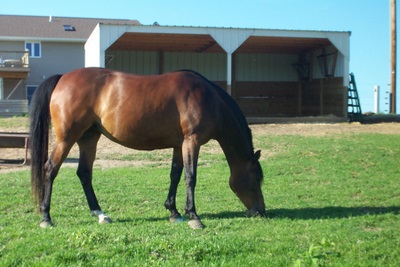
|
| Member: rtrotter |
Posted on Sunday, Jul 12, 2009 - 5:42 pm: Elk,Maybe I can help you get your mind around being obese and under nourished ( or should I say mal- nourished). Its a vicious circle, in my opinion. I will use myself as an example. I have lived my entire life with Celiac disease. This is an allergic reaction to glutens found in all the stuff I love to eat, pasta, cake, cookies, candy bars, ice cream. I have had this since I was six months old and it was treated with a special very restricted diet, which was supposed to cure it after a period of years. IMO it did not and I suffer from some of the effects of the diet and the disease. One of the side effects of this disease is that the intestines do not function correctly and thus the nutrition one gets is limited (mostly everything passes through the digestive tract and next to nothing gets utilized for bodily functions leaving one mal-nourished as far as vitamins and minerals. In order to maintain proper nutritional balance, the body craves different food items in excess in an attempt to replace what it perceives it is not receiving in the correct amounts. This leads to weight gain and an inability to stop eating (like I said a vicious circle).It can be controlled, but IMO not cured. Now for some observations with regards to humans and horses. Humans were hunters and gatherers, until 10,000 years ago when agriculture came along and we stopped moving about to collect our food. Our bodies up to that point dealt with fruits, vegetables and meat and IMO is what we should still be eating today, if all the other food types were not as easily accessible. We at least have a choice as to what we put in our mouths, our horses do not. Horses also have their movement restricted and they rely on people to give them what they previously could get on their own. Horses given enough range and left to their own devices would satisfy their nutritional requirements without human intervention, they would eat bark and grass and leaves and wood because they are herbavores and this stuff is part of their natural diet. We choose to change the equation for our own purposes, so we have to deal with the consequences of whatever our management program is. So to answer your question about horses being fat and undernourished (mal-nourished), yes that is very possible, in fact, IMO it is more the rule than the exception. In Dianes case she has found a connection that works for her horses. I also think that she will in time find out that she will be able to leave them out on pasture 24/7(no clover or stressed grass) because as I have noticed with my own horses, they will limit themselves and will not spend their lives with their heads buried in the grass as long as their correct nutritional requirements are being met. IMO (I have lots of opinions today)this holds true for people and for horses. Exercise and met nutritional requirements in whatever form is necessary makes for optimal horses and people.Now if I could only follow my own advice, I'd be a lot healthier and happier. Sorry for the long post and If I misunderstood what you were saying. Rachelle |
| Member: ajudson1 |
Posted on Monday, Jul 13, 2009 - 11:28 am: Ladies,I love the above posts. Each and everyone one of you have ideas based on what you have experienced. I love Elizabeths way, sparse pasture, exercise, etc. Sounds so simple doesn't it? And if we could all offer that, would the problems with hoofs, and IR, be solved? Are these totally manmade problems, just as some of our diseases are? Based on what I've experienced with my horses this summer, it would seem so. This is the first time in having horses for 36 years that I have FAT horses, and possibly laminitis. At least some lameness issues that being overwieght isn't helping. (My typing is doing the invisible thing again, letters show up late, excuse the spelling ) First time I have LUSH pastures. Geez, glad I seeded, fertilized, and then we got all kinds of rain, perfect grass growing weather. And of course, can't exercise lame horses. Rachelle, I do understand what you are saying, having suffered with CFS since my teens. I also know I can't eat junk, caffiene, I can't handle, and part of the problem I have is I don't get what I need from all food. I believe in "colon cleanses" which isn't accepted by the medical profession. I am talking just taking daily fiber products. Not to trun this into a discussion about BM's, and the intestines, but back to what PR was explaining on the DVD...the part I haven't got a grasp on yet, something happens in the horses digestion with high sugar grass, and also happens when we put horses on our schedule of 3 meals a day, or limiting hay for getting weight off. It sounds like it MAY be just as bad to feed a flake of hay morning and night, to slim down a horse, as it is to let them graze 24/7, because they both cause something to happen that causes the inflammation. IF the grazing is the high sugar grasses? I think of these ideas being put out there, that are not all 100% proven, as what will be accepted without question very soon. My opinion based on my experiences of course. Note this: When I got help that gave my me life back, it was from an "Alternative (GASP!) Clinic" Which insurance didn't help with much. THey did things like gave me a C-R Reactive blood test(I think I have that wrong, sorry). My doctor here never heard of it; now it's pretty standard testing. The Thermo scanning in place of mammograms, also offered there 8 years ago; hearing more about that. 'Nways, if Pete, or others, believe in "Metabolic Imbalances" to help keep our horses sound, I am interested, even if it's not proven, YET. Oh, Elizabeth, I hear you on the "sell me something." I argued a long time with my myself over parting with $250.00 for PR's DVDs. I finally decided it was like 2 1/2 farrier visits, and I figure I will have horses for many years yet, plus I know there is much I don't understand. I don't appreciate getting offers now to buy more though. Yet I can't fault a man for making a living. Funny, what if everyone kept their horses on sparse pastures, lots of exercise, etc.? The natural trim guys would have lot less customers, huh? If it's that simple. |
| Member: ekaufman |
Posted on Monday, Jul 13, 2009 - 12:28 pm: I always broaden my thinking on this site-- one of many reasons I love it. And as I think about this issue, I can come up with examples of horses in good condition with nice coats/bright eyes that may have nutritional deficits (I write this as I'm dosing several of my horses with thousands of IU Vit. E/day).I guess with these horses who tend towards obesity, IR or not, the question is whether they have a yet-unproven deficit and, in the meantime, whether we optimize for body condition (my current management) or horsey lifestyle. I think, Diane, that you're trying to find more of a middle ground, if I've understood correctly. Fundamentally I agree with Rachelle, who makes the point that a "natural" horse lifestyle is not as luxurious as a pasture life, but involves a lot of travel for safety, water and mixed (often poor) forage. Some day Purina will charge us $18 for a bag of cruddy grass and twigs! |
| Member: ajudson1 |
Posted on Monday, Jul 13, 2009 - 1:52 pm: Huh, isn't that was is in Safe Choice? Seems we had a discussion on that and never did get a clear answer on what all the "by-products" were listed on the ingredients tag. Seems we had a discussion on that and never did get a clear answer on what all the "by-products" were listed on the ingredients tag. I am thinking of going back to just a small amount of oats, that way I can see what the ingredients are! |
| Member: scooter |
Posted on Monday, Jul 13, 2009 - 5:22 pm: No I am not taking the middle road, I am taking a completely different road . . I guess my point is most IR horses have "triggers" that will send them spiraling into laminitis. Through observation through the years I have been finding out what they are...for some reason the clover/stressed grass (especially clover) link never came to mind! The vet was here today for Hanks fetlock, he is like me and the 1st thing he checks on that horse is his DP no matter what he is here for...completely absent, he looked a little closer at Hank and said holy crap what have you been doing to him..Hank and Sam look great(other than the shave job!  Told him the same thing I did the other day...no clover and non-stressed grass/ration balancer. He said they looked very good and said getting rid of that clover was the best thing I could have done for him. Told him the same thing I did the other day...no clover and non-stressed grass/ration balancer. He said they looked very good and said getting rid of that clover was the best thing I could have done for him. He again offered up his Thro-L concoction and I said I don't think I need it. He looked at Hank and said You are right! He said what if we drew blood and his insulin was off he charts(we always play the what if game for some reason) I said I was confident his insulin is with-in reason now...He agreed  . I was considering it before this experiment, those continuous DP's were driving me nuts! . I was considering it before this experiment, those continuous DP's were driving me nuts! Angie if you are worried about your horses getting fat and need something to feed them for supplements. A small handful of soaked alfalfa pellets go along ways in cutting carbs, with adding a little protein...no fillers and a #50 bag is cheaper then any feed. I'm very happy so far with this experiment and my vet(the fat patrol) gives his blessing. I love the way you people make me think too! Thanks |
| Member: rtrotter |
Posted on Monday, Jul 13, 2009 - 6:27 pm: So, basically what you now have is "normal" horses.Weight in normal range. No DP Pulses. No laminitis. Able to go out and graze. They act normal are beginning to look normal and the vet says they are great. I think you have done a wonderful job, now if only Hank would cooperate with his fetlock, all would be well. Rachelle |
| Member: scooter |
Posted on Monday, Jul 13, 2009 - 9:01 pm: HUH? I never thought I would read something like that pertaining to Hank and Sam...you are right They are almost "normal" horses! Thanks Rachelle! They are almost "normal" horses! Thanks Rachelle! I had to re-read that a few times  Then I thought by George she is right!!! Then I thought by George she is right!!! Hank is getting a little flabby from lack of exercise (his weight is the same tho) he has lost about #20's without being on a diet and NO exercise...how weird is that?? Here's my handsome man with his broken leg  . He still has some weird fat going on and of course that lovely cresty neck...but it is all changing slowly, but surely. . He still has some weird fat going on and of course that lovely cresty neck...but it is all changing slowly, but surely. 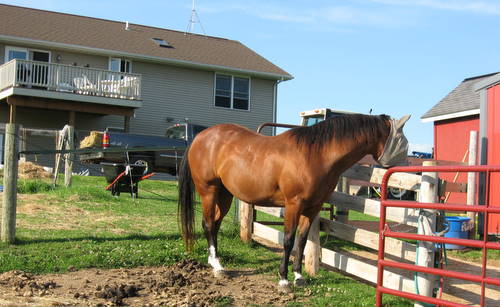 Here is the grass they can graze all day with seemingly(so far) no ill effects)  Notice it is not chewed down to dirt, like they do the clover pasture Notice it is not chewed down to dirt, like they do the clover pasture 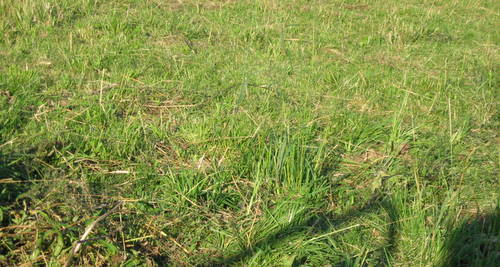
|
| Member: scooter |
Posted on Thursday, Jul 16, 2009 - 6:33 pm: Interesting enough the farrier was here today and I told him about my clover killing experiment.He kind of shook his head and said it reminded him of one of his clients. He said the guys pasture was kind of dying out so he seeded it down with clover last fall, once it grew this spring. He said the pasture was all clover... all 3 of the horses foundered, they never had before. He said he thought it was a great idea too  An aside note Hanks feet look better than they have for a long time...the white line at the toe is ALMOST normal. Where he flares on the side is still stretched, but now that I have the Riders rasp I am hoping I can keep those flares in check between farrier visits. He walked away sound on HARD ground  I am VERY nervous about this, but this weekend I think I may let them try the new cloverless pasture for an hour or so. We had a gully washing rain the other night and a little more expected so I think it will be safe...as far as the herbicide goes and the grass! Keep hooves crossed! |
| Moderator: DrO |
Posted on Friday, Jul 17, 2009 - 8:02 am: I would like to emphasize to those folks with hard working horses or that are not easy keepers, white clover in the pasture is one of the best things you can do for your horses. It's removal is justified to help maintain proper condition on easy keepers.DrO |
| Member: scooter |
Posted on Saturday, Jul 18, 2009 - 10:48 am: I decided to go ahead and let the horses(including Flash)out on the new cloverless pasture, the grass is about 4-5in tall. There is still a small amount of clover in there and that arab gelding is drawn right to them gees. I chased him off. Hanks is walking much better out there with out his pads!(that's a different thread tho) Anyway I have been watching them, they are quite different in this pasture then they used to be. They are walking around ripping tall grass off.,NOT eating like pigs on corn. Really is quite a difference. Hanks neck is looking better, Sams is almost gone along with those fat leg lumps. Patty I am no nutritionist, but I would have a hard time feeding my prone to be fat horses a fat supplement  I did at one time try it on the old mare and she piled weight on very quickly. Have you looked into the ration balancers? OR what exactly his pasture consists of. As Dr.O. says "normal" horses can tolerate clover and grass just fine...our type not so much! I did at one time try it on the old mare and she piled weight on very quickly. Have you looked into the ration balancers? OR what exactly his pasture consists of. As Dr.O. says "normal" horses can tolerate clover and grass just fine...our type not so much! So if you read the above I am trying very hard to take away the carbs(as much a feasibly possible) yet let them live "normally" on low carb grass. We'll see how this turns out. There diet at this time is 1 poundish of the gro n win, 6lbs. of very crappy hay and turnout on pasture...the one I had them in I was letting them out for about 4 hrs. My new experimental one is going to be "worked up to 4 hrs starting with 1 hr. today. Unfortunately Hank is lame from pulling his shoes so I am going to be extra careful with him. I will take pics of his neck tonight, I haven't done it for awhile. |
| Member: scooter |
Posted on Saturday, Jul 18, 2009 - 11:24 am:  OMG the horses don't really like that cloverless/no stressed grass pasture much! I'll have to watch them over the weekend, but at this point I wouldn't be afraid to leave them out in it for a few hrs.! They just brought themselves in before an hour was even up OMG the horses don't really like that cloverless/no stressed grass pasture much! I'll have to watch them over the weekend, but at this point I wouldn't be afraid to leave them out in it for a few hrs.! They just brought themselves in before an hour was even up . . I'm going to let them come and go as they please today (within reason) Hanks hooves love it out there...his mouth not so much...PERFECT! I did spray a small small patches of clover that was left in it last weekend...there wasn't much. Other than that it hasn't been sprayed for 3 weeks and we have had multiple BIG rains. The 24-d wouldn't be making them not such hogs would it??? The directions say 2 weeks. Just weird, I love it! |
| Member: scooter |
Posted on Sunday, Jul 19, 2009 - 11:50 am: I truly had forgotten how normal horses graze, how strange is that! I threw the horses a leaf of hay this morning, opened the gate to the pasture. Hank and Flash munched hay for awhile, Sam went directly out to the experimental pasture. He sniffed around, picked a little bit, looked for the clover patches, and grazed slowly.Finally Flash joined him, she picked around a bit, and actually came back up to the "dry lot" to chew on that small clover/short grass patch I haven't killed yet...That the boys have gnawed down to dirt, she still thought it was better then that tall grass with no clover. Hank joined them a few minutes later, picked around, went to the bathroom  , rolled, picked around some more, and now they are back up getting a drink and napping. Hank did manage to find a thistle in the fence line and devour that LOL. , rolled, picked around some more, and now they are back up getting a drink and napping. Hank did manage to find a thistle in the fence line and devour that LOL. I REALLY can't believe how well this going! I haven't seen Hank graze "normally" since he was born(honestly) he always looked possesed! Hopefully by the time they have this side grazed down (and not short) because I have seen the shorter the pasture,, the more the clover flourishes, and the more they like it! My other side should be ready before that happens! I don't really know how to act! I am so used to bringing them in after an hour of grazing, fretting about laminitis, ect. it's hard not to. They have not stayed out there for a whole hour at a time yet anyway! Normal horses, a whole nuther concept for me! I'll probably get bored, since I don't seem to have to micro-manage their turnout! Or maybe I will clean the house, naw think I'll sit on the deck and watch my "normal" horses graze "normally" I hope this isn't too good to be true! I am going to weigh them tonight and see how that's going. |
| Member: scooter |
Posted on Sunday, Jul 19, 2009 - 12:28 pm: For those of you who are interested, Here is a pic of their empty pasture They could be out grazing if they preferred. It is cool and the bugs are not bad. They could be out grazing if they preferred. It is cool and the bugs are not bad. 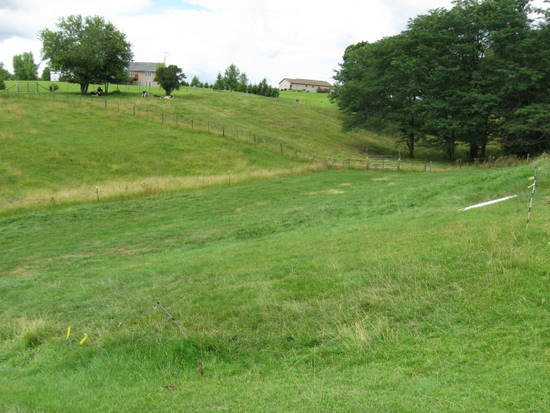 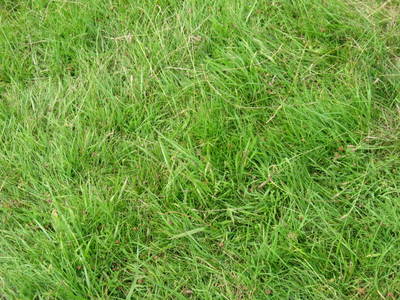 Not even eating their leftover hay..wonder if they are sick? 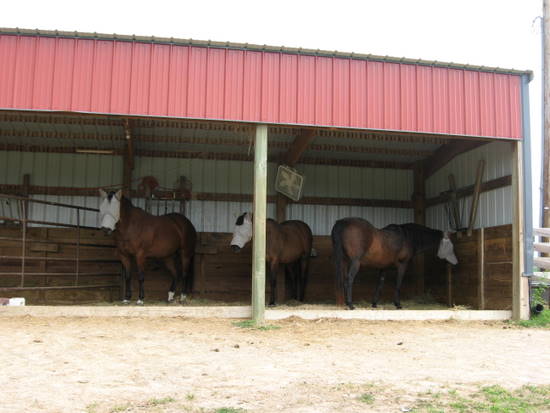
|
| Member: pattyb |
Posted on Sunday, Jul 19, 2009 - 12:54 pm: Greetings and good day to all. Diane, I thought and thought about the question of adding fat calories and have 2 emails waiting for replies from my "IR gurus." I hope to get some info on this today or tomorrow....... My dilemma seems to be that if I try to increase turnout time, I start to see the voracious appetite and increased urination creeping back in.....and the same goes for increasing hay. If I run into trouble trying to increase carbs, what are my other options? There is NO clover in my turnout area or in the hay so it has to be the carbs....or that would be my best guess....and that is why the feed specialist suggested low dosing rice bran oil while watching weight carefully. I'm open to all ideas so thought this one was worth trying. Personally, I would rather increase the hay but it seems to backfire every time I try.......sigh. Grass carbs are enemy #1, hay carbs enemy #2.....so what on earth do you do? This really is a tough one, I hope I have some info soon to share.....ugh, my brain is so tired. The bottle of rice bran oil suggests 2-4 ounces for performance or weight gain, I'm using one ounce hoping for weight stability, could use 1/2 if that's to much. I'll keep you posted after I start getting the email replies........... |
| Member: scooter |
Posted on Sunday, Jul 19, 2009 - 2:01 pm: Patty, I do not only think it is the clover, but also the stressed grass. I'm sure you have researched this thourorly., but from my research grass can be kept somewhat low carb...if you haven't visited www.safergrass.org here are the articles https://www.safergrass.org/articles/index.html I would highly recommend it. Mine acted like they were starved eating that clover/short grass/weeeds also.Is Ziggy on short pasture,weeds?? Have you tried soaking his hay? If it is not working, try to figure out where the carbs(triggers) are coming from that don't agree with him....eliminate it,, or change it and replace it with something low carb. Is there a special area he likes in the pasture? They usually spend most of their time at the sweetest places! As I said above somewhere. grass/forage is not the enemy, it is good for them nutritionally and mentally and their natural staple...it's just finding the right situation that works for you and your horse. |
| Member: pattyb |
Posted on Monday, Jul 20, 2009 - 10:31 am: Good morning Diane (and your readers). I'm in a big hurry here so please forgive me if I jump from subject to subject without much "Lead into." I tried the taller grass a few years ago and everyone blew up on it....darn it. The only way I could control their weights was to set up a sacrifice area.....the grass grew but they could eat it as fast as it grew so it never got tall. In theory, it shouldn't have worked but it did every year since then. The emails I received back backed up what you said about increasing hay for forage however, if that presented problems with IR symptoms, the fat idea was a good one in terms of a lower glycemic diet. Naturally, I have to be very careful not to pack on the weight but it was, in their educated opinions, worth a try to see what he does. What I can report after 3 days of grazing on short field, lower end hay amount, low end Triple Crown Lite with rice bran oil added is: He was much calmer last night for grooming, didn't attack his hay like he was starving and-----> for the second morning in a row, this morning I noticed his favorite urine spot is not as saturated. I noticed it yesterday morning but thought maybe it was just a fluke...but there it was again this morning. Hmmmmmm, maybe he does need a low glycemic diet. During the rest of the year, the lower end hay amount never seemed to have a negative affect on him, even in the winter. Actually, winter was his best time so far as attitude (opposite what you would think) however, I did put extra hay out when there was snow on the ground and he did fine with that. Gotta zoooom, wish I could stay longer but wanted you to know I read your reply and combined it with the emails I received on this subject from two vets that specialize in equine nutrition. Ziggy is what he is, I just have to figure out what that "is" is...ugh,lol.  He never was simple, he needs to show up in someone's book in the chapter on difficult cases. He never was simple, he needs to show up in someone's book in the chapter on difficult cases.
|
| Member: scooter |
Posted on Monday, Jul 20, 2009 - 11:15 pm: Actually if you think about it winter is the best time for IR horses. No grass when there is snow on the ground, not quite as many "triggers" Most horses prefer winter, I know mine do (as long as it doesn't get too extreme)I have to say, if you are worried about IR I would be highly suspecting that short grass according to most theories anyway. You read of my "dry lot" experience? I have noticed with the tall grass they get fuller faster. When working thru the week. I am letting them out for a couple hours when I get home. They are not real interested in their hay because they feel full, rather than having a "sugar high" from short grass, and also in my case clover. Sam has quit urinating all the time too(I was getting real sick of him watering down the bedding) Hank didn't seem to get that effect even tho he is a much bigger drinker then Sam. I think they would blow up on that tall grass too if they were left out 24/7. From my observation they aren't quite the pigs they were on the "sweet stuff" but I still won't risk 24/7 at this point. A few hrs. seems to fill them up, without the carbs, much more so then the short sweet stuff and they seem "satisfied" I don't have to chase them up off the tall grass when I call they come in. I had to chase them round and round to get them off the short grass/clover. I have also been successful the last couple years with the short stuff....but the IR symptoms did persist, and still do but not to such an extreme and we are early in our experiment. It may not even work...at this point it is. They are all different tho as we know 
|
| Member: pattyb |
Posted on Wednesday, Jul 22, 2009 - 1:23 pm: Good afternoon Diane. I tried to get back to you last night but was up until 1:30 researching an issue I have with one of the Nubian goats that even my vet is stymied by. We're both brainstorming and comparing thoughts by Friday. I ran the Safe Starch forage idea past the feed specialist that is helping me at the farm store. She suggested maybe adding some of that to his haynet to boost fiber content without adding a whole lot of calories. I can also still use the Rice Bran Oil Plus to help control his weight while also using it to keep him on a low carb/higher fat diet. I read a lot after Googling that type of diet and for some horses that have starch or sugar issues, it's a good approach as long as it's not overdone.....as in not packing on the weight, just using it to stabilize weight. Anyway, that's where I'm at......and wondering how your mineral mix is working for you, any updates? 
|
| Member: scooter |
Posted on Wednesday, Jul 22, 2009 - 8:45 pm: Hank and friends are holding their own on 4-6 hrs. of turn out on the "experimental pasture" Hank is getting flabby looking since he can't exercise right now. They are also getting the same amount of hay, 6lbish and their ration balancer. He hasn't lost any weight nor gained any since his initial loss of 20lbs.His cresty neck seems to be "leveling off" instead of sticking straight up in the air, and being hard as rock it is much softer now. Since getting over the pull the shoe soreness hump, his DP's remain quiet. Neck collage..the first pic is from the 6-20 the second tonight. 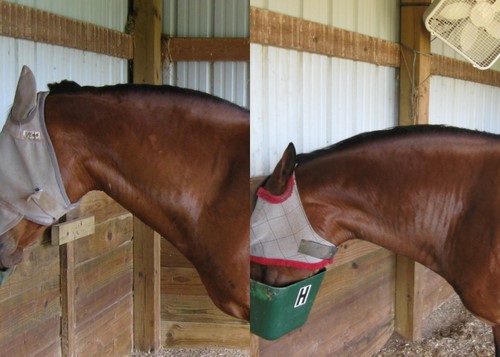 The Old girl released from jail, looking at the grass wondering if I have lost my mind letting them out in all of this WONDERFUL stuff  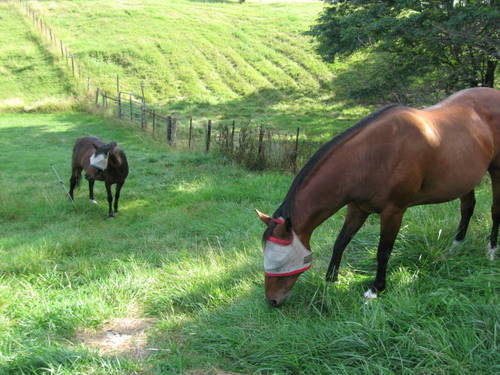
|
| Member: lilo |
Posted on Thursday, Jul 23, 2009 - 9:22 am: Diane - your tall grass looks so much more lush than my grass at this time a year. Wishing you continued luck with your "experiment".Lilo |
| Member: scooter |
Posted on Sunday, Jul 26, 2009 - 11:11 am: Dr.O. The horses bcs is about a 6. They have been going on the "experimental pasture" for 4-6 hrs. a day with no ill effects and no weight gain.We are having one weird summer here, it has been the coldest July on record so far and the cool season grasses are still thriving. The clover has been eliminated. I would like to start letting the horses out longer when I'm working. So they would go out about 630 AM and be brought in around 4pm. For some reason this scares me  I think I would just eliminate the morning hay and let them out, and at night give them 1 leaf (about 2-3lbs) of poor quality hay. So the grass would be their main forage. I am so programmed to be afraid of founder I am not sure if I am being unreasonable in my thinking! I would monitor their weight carefully. I think I would just eliminate the morning hay and let them out, and at night give them 1 leaf (about 2-3lbs) of poor quality hay. So the grass would be their main forage. I am so programmed to be afraid of founder I am not sure if I am being unreasonable in my thinking! I would monitor their weight carefully. I know you haven't a crystal ball, but wondered if you had any opinions as to if you think this is unreasonable... considering their history of founder and IR Thanks |
| Member: pattyb |
Posted on Sunday, Jul 26, 2009 - 12:09 pm: Good morning Diane. I'm wondering what his opinion is too....... I'm wondering what his opinion is too....... The last few days, I've been cutting back on grass time while upping the hay a little with the Safe Starch Forage. I had hoped that now that Ziggy is of prime weight, he could spend more time out on grass but what I found was that even as he was still losing a little weight, the grass (sugars) were sending him up the IR flagpole......by evening he was doing the "I'm starving" gig with his ears back most of the time. As I cut back on grass time, he improved in eating habits and attitude. I'm sure all this cool weather spring/fall grass is not helping as he was doing great when it was drying up from summer heat..which we haven't seen in over a month. To make up for the lack of extended grass time, I'm adding the Safe Starch so he doesn't lose weight, along with a small amount of Rice Bran Oil Plus. What I can say for sure is that right now, as he did in the winter, 3 or 4 hours is the maximum he can take of real grass, regardless of it's color. I found that even dead winter grass is loaded with sugar so, it made no difference that it was dead grass, the sugar was still there. Hay somehow is not quite as bad but I still have to be careful not to give him to much or that invokes the same response as to much grass does. By using Safe Starch, I can at least increase his hay amount without throwing quite as many carbs at him, it's guaranteed to be 10% NSC or less. I'm really glad that you have been able to put yours out in that beautiful pasture. Mine looks like that too, from all this rain we've had, and I know from past experience with my Cushing's horse that I can't seem to get away with that, especially now that my summer sparse grass has been replaced with well hydrated spring/fall grass....darn it. I'm sooooo sick of rain, the farmers can't even bale their hay around here because we never get more than one day without rain.....which wrecks havoc on trying to get dry sawdust too. Anyway, anxious to hear what Dr. O has to say as I would be very hesitant but possibly just overly cautious on my part. 
|
| Member: scooter |
Posted on Sunday, Jul 26, 2009 - 1:21 pm: Yes Patty my gut usually tells me what I should do in cases like this...but it's not this time They have been doing very well on their grass turnout. It's just the years of continuous founder may have me a little more "scared" then I truly should be. Letting them be "normal" is HARD! They have been doing very well on their grass turnout. It's just the years of continuous founder may have me a little more "scared" then I truly should be. Letting them be "normal" is HARD! Mine don't seem to get the attitude you describe Ziggy as getting, but then again they know better then to pull an attitude on me too, it is not acceptable in my presence, so maybe that's why. They have most definitely lost the "I'm starving" behavior tho. I just wish Hanks fetlock would heal up so I could start working him again, then I wouldn't worry so much about it. One more week according to the vet, but we are going to re-val first. This cool weather is perfect for riding! I'd put money on when he was finally sound to ride it will be 100 degrees and humid! We haven't got 2nd crop hay up yet either 
|
| Moderator: DrO |
Posted on Monday, Jul 27, 2009 - 8:04 am: You are right Diane no crystal ball here. But I do have a recommendation, why don't you increase the amount of time on pasture slower rather than jumping from 5 to 10 hours. If it is a problem you might catch it in a milder form.DrO |
| Member: scooter |
Posted on Monday, Jul 27, 2009 - 7:17 pm: Thanks Dr.O I USUALLY can't come home from work and put them in, depends where I am.Yesterday I decided to let them out for about 8 hrs. this mornig and this afternoon everything was FINE! Actually Hank seems to move better the longer he is out. His front hooves have almost lost the DP, when he comes in from pasture they are usually completely gone  I guess it is a balancing act riddled with maybe's! I didn't let them out this morning, It just scares me for some reason. I think I will do the longer turnouts on the weekends when I'm around and see how it goes. Once I loose my anxiety I may try it everyday. Thanks |
| Member: scooter |
Posted on Friday, Jul 31, 2009 - 8:18 am: Interesting observation today. I have decided to let the old mare out of jail at night, but made a bad decision.Since the mare was going to be out with the geldings I decided I should make the "dry pen" bigger. I have had it fenced off from all grazing and haven't sprayed it yet. It is still short from before this experiment as I HAD been letting the geldings graze there. It has quite a bit of clover, but I figured since 3 horses would be in it they wouldn't get much. I only enlarged the area by about 15 x 25 feet. Thank goodness I didn't open the whole area... The geldings necks are standing up again and they are foot sore. Hank don't want to walk on the hard ground again and is sidling along the fence line to stay off the hard paddock and hard ground, tight circles are bad again, DrOoling has begun. Any of you that watched my fetlock video could see he was not foot sore before this, and his neck was just about normal. That video was on HARD ground, I didn't harrow the arena 1st and it hasn't been harrowed since his injury. It is hard like his paddock area. I think I am finally right and this clover and/short grass....even that LITTLE bit has been MOST of their problem all along. Hard to believe that a small area could do this. Of course the old mare who can tolerate it is fine. They have been spending about 4-6 hours on NO clover and NO stressed grass and have been doing WONDERFUL. Just amazing, now we have to get over the sore footiness again...which I'm sure is laminitis  Hanks DP's are bounding again. Mare is going back in jail at night, and the dry lot is fenced off again! Hanks DP's are bounding again. Mare is going back in jail at night, and the dry lot is fenced off again! JULY 31st |
| Member: ajudson1 |
Posted on Friday, Jul 31, 2009 - 10:23 am: Diane,I've been doing some experimenting while following your experiment. Tango was sore in front, pounding DP at times. So I tried letting him graze the long grass, limiting time. Let him graze short grass, limiting time. Both areas have some clover, not much. Left him in the round pen, just hay. What I found was the sore feet, DP, came back after all the above. What was different? The days he ran and bucked, and had a blast wearing off energy! So....watched more of PR's DVD's, took a gamble that a phone call to my hoof gal in Alaska wasn't going to cost me a buck a minute,and got more help with my trimming. For ME, or rather for Tango, it seems to be a hoof issue! All to do with circulation do to the hoofs not being in their best form. Bar issues. Not enough toe HEIGHT. Beveling not done enough. NOthing that shows up at first glance, to my eye anyhow, but enough things that have built up over time. My conclusion from my experiences at this point is with proper hoof form, these things have a harder time showing up. The clover, high sugar grasses can cause the inflammation, but less likely to happen if the hoof is trimmed correctly. Because the circulation is good in the hoof. Of course with plenty of movement too. A poor hoof form, can cause the inflammation, grass or no grass...grain or no grain. From bars pushing up in the hoof, too much wall pressure, too much sole pressure, lack of frog stimulation. It's a balancing act no doubt. I would be curious as to what would happen if you had a different trimmer. Of course keep killing the clover for now. My next plan is to do what Jackson has wrote about. I am going to make a track around the inside perimeter of my largest pasture. He says horses will run and move so much more if they have a place to go. Space out hay, gravel, salt, a mud hole etc. He says horses can loose 200 pounds in a few months just from that change. The movement , change in footing is so healthy for them; hoofs, weight, emotionally. I will still let them graze the main pastures of course, but it will be controlled. Leaving for a week, so won't get started on that for awhile. But I will start a discussion on it as it progresses. If you decide to try it, let me know how it works out. Maybe you can do it first, lol! |
| Member: scooter |
Posted on Friday, Jul 31, 2009 - 10:46 am: HMMMM well in a way when my horses on on their "experimental pasture" it is a bit like a track. They have to walk on gravel, limestone, hard ground, soft ground. He ALWAYS moves better when coming out of THAT pasture.I don't think it is his hoof form, it could definitely use some improvement, but just from the way the DP's disappeared when removing the clover tells me something. After the initial 2 weeks of barefoot shock he WAS doing great...if you saw the fetlock video, he doesn't look sore footed on that hard limestone. Sam is following his exact path...they both get sore at the same time....The mare did NOT....same farrier. I do agree with you that bad trimming can cause the same effect, but my horses problems seem to be waxing and waning with the clover and short grass. The 2 IR horses had been moving great...until my mistake. I don't think mine could tolerate the clover at this point even with a perfect hoof (if there is such a thing)  I would almost bet my last dollar that adding a track would not equate into 200 lbs of weight loss in mine  UNLESS I changed their diet somehow. Before Hank hurt his fetlock he was getting a pretty good work out 4-5 days a week and didn't loose a pound UNLESS I changed their diet somehow. Before Hank hurt his fetlock he was getting a pretty good work out 4-5 days a week and didn't loose a pound It does help keep the DP's away tho. He is not horribly fat as he used to be, but could stand to loose a little, or at least get back in shape! It does help keep the DP's away tho. He is not horribly fat as he used to be, but could stand to loose a little, or at least get back in shape! Is Tango the only one of yours that is getting sore? |
| Member: ajudson1 |
Posted on Friday, Jul 31, 2009 - 11:15 am: https://thenaturalhoof.homestead.com/PaddockParadise.htmlDiane, here's a good link, many out there, just google Paddock Paradise. I am just now reading the above, sounds like she has a horse like Hank, and that horse is grazing normally. All I can say is read what others have done, and the results they experienced. I can't vouch for it YET. BUt it makes so much sense to my mind. It would be easier for you to do as you have hills and rocks, I have flat lush pastures, sandy loam soil. I can add small amounts of hay through out the day easier than you can I guess. But you have more sapce to work with too. I will have dirt soon, building a garage. And gravel as we change the driveway. Heavy equipment hired too. So now is the time for me to do this. Yes, only Tango...maybe the Morgan in him? Or the fact I messed up his hoofs the worst as I continue my learning to trim journey? BTW, I would bet you that IF you follow the concepts of the "track feeding/movement paddock paradise" exactly as laid out, Hank would get down to his best weight. You would be changing their diets, but not drastically, just more "natural" movement, sparse grazing. Or hay. BTW, very difficult for me to type on this discussion, again, it's a long thread, and I have the delay in seeing my words show up! |
| Member: pattyb |
Posted on Sunday, Aug 2, 2009 - 5:36 pm: Greetings and good day to all. Diane...I'm still following your experiments and spent a good amount of time reading the Safergrass website you posted the link for.....very interesting info. I have to admit though, my past experiences always had me pulling them off of the full pasture and putting them into a smaller area for weight control...which is contrary to everything I just read unless, my big pasture is loaded with clover. Because of the rain, I only had a brief gaze at what's in the grass out there and yes, there are clover patches in the big field that I don't have in the smaller arena. But yet again, I have to limit their time in the big field even when the grass is dead in the winter so I'm not sure what to think on this yet..... The other reason I'm stopping in is to report that I am making hay tea now...as a measure to increase hay amounts without overloading the carbs. I thought Safergrass had a very informative chart on this subject and couldn't help but laugh when I saw the hay beer....lol.  I hadn't thought of that until I read the comment but yup, I could see beer there. I hadn't thought of that until I read the comment but yup, I could see beer there. Today I went for a load of first cut orchard grass and it's good and stemmy....just like I prefer to feed the Zigman. The fella there was glad to sell it to me as most people aren't looking for first cut....to which I admitted I need softer hay for the other older horse. Right now, my plan is to go back for some of both later this week. Anyway, I'm sorry to see you have had a setback. Maybe clover is my problem in the big field and that would explain why mine do better in the short stuff without clover? Before I head out the door, I have a question to ask that I know has been asked before but I'm not sure where.----> How long can you soak hay in cold water and still have it viable? Ziggy already eats the "soaked for an hour" hay faster than when it's dry but how long can you soak it in cold water for? Is there a point it would turn to mush and not be very filling? I would think there is but is 2-4 hours out of the question? An hour prior works but sometimes other times are more convenient....so, I was just wondering. I do know someone asked that question but I don't remember where, if you do, just point me in that direction....please.  Good luck on a speedy recovery so you can get back to experimenting and teaching those of us following you. 
|
| Member: scooter |
Posted on Monday, Aug 3, 2009 - 6:20 am: Patty, when I worked at the eventing barn we had a copd pony, we soaked his hay between meals. So it was soaked for 8-12 hrs. a day. We always kept it in the barn so the hot summer sun didn't heat it up too much. We had no problems with this.Hanks DP went back to normal yesterday, I have been continuing to leave them in the "experimental pasture" even when the DP's appeared. I am pretty confident at this point that "normal" grass isn't his problem. I still haven't been brave enough to leave them out longer than 4-6 hrs. He needs to loose weight anyway, so longer isn't appropriate now, hopefully I can get him back into some kind of work schedule soon. When I get him back in an exercise regimen I may up the "pasture" time. Angie I have read about the tracks before and with observation of my own it probably wouldn't be a bad idea. I don't have a lot of room to work with in the summer/fall months because the heifers are in the pastures surrounding the horses. I would really rather exercise Hank by riding or liberty work if I could get those hooves feeling better, and decide just what is wrong with his fetlock. Since you are having problems loading this, next update I will start a different thread, I like your input 
|
| Member: pattyb |
Posted on Friday, Aug 7, 2009 - 10:22 am: Good morning Diane. Thanks for the info on the hay. I've been soaking it for an hour and a half each go round and it definitely helps him....will probably have to buy a heated tub for winter soaking but I have plenty of time to get ready for that....they have one out there now but it's for their winter water. I was wondering if you had any more info, or insights, to add concerning the mineral mix/cresty neck experiment? I know you started a new thread about the fetlock but I was wondering how that experiment was going or if it's in a different thread now? Ziggy's grain is still Triple Crown Lite, mostly just vitamins and minerals, and I did read an article last weekend about IR horses and boosting their vit/min supplements to 150% of rec. daily allowance since they do seem to urinate more than most. When I consider that idea, I'm right in the range for his weight plus a little extra for the urine output......which reminds me....an interesting stall trick: One of the fellas at the farm store said that for those that seem to pee in their stalls a lot, and in the same place, he digs a hole with a post hole digger as deep as he can go, then fills the hole with rocks, all of which sits quite buried by the bedding. If placed correctly, the urine will seep way down below into the rock "pit" therefore saving on bedding quite a bit. I'm going to try that real soon as Ziggy is definitely one for peeing in the same spot creating a puddle under the sawdust. Gotta run......................... |
| Member: scooter |
Posted on Friday, Aug 7, 2009 - 2:30 pm: Hi Patty, I guess my experiments have run together. . I haven't measured Hanks neck for awhile, but I definitely have made many observations during this experiment regarding his neck and body condition. I figured people would think I was nuts so didn't post them, but I guess most members know I'm a little out there anyway....so here goes . I haven't measured Hanks neck for awhile, but I definitely have made many observations during this experiment regarding his neck and body condition. I figured people would think I was nuts so didn't post them, but I guess most members know I'm a little out there anyway....so here goes 1st let me address the high urination...I believe in mine, the addition of Mg. is contributing to it. Sam has always urinated more then "normal" but it is MUCH more than normal with the addition of Mg. Hank has always been "normal" in that regard, but has increased 3 fold with the addition of Mg. I took them off it to see if it would make a difference and it most difinitely did. Hanks neck is weird for sure that thing tells me many stories  . as in when I left them in the "dry lot" with clover..minerals or not that thing grew huge and hard overnight. I'd still like to know what the physics is behind that??? People other than me have made that observation too. I know that a cresty neck is basically excess fat, but something else has to be at work within that fat to make it do that! . as in when I left them in the "dry lot" with clover..minerals or not that thing grew huge and hard overnight. I'd still like to know what the physics is behind that??? People other than me have made that observation too. I know that a cresty neck is basically excess fat, but something else has to be at work within that fat to make it do that! It took that boy a week to get his body to recover from that "mistake" he looked bloated, and very cresty. I do have proof of the difference within a day or two as that was when I was videoing his liberty work and fetlock problem I can see a BIG difference in his body in those videos...weird I know, but true. Even barefoot he was moving pretty well for him, but after the clover/stressed grass night he was VERY sore. Which leads me to another observation, when Hank has sore hooves his crest is hard and big, when his hooves feel good it seems to shrink....I haven't quite figured out if this is the chicken or the egg. Does his crest get hard and big because his feet hurt OR Do his feet hurt and his crest grows because of some sort of trigger??? I have always noticed (for years) that his crest is always HUGE when his hooves hurt, even in the winter. Is it possible pain in the hoof sends some sort of physical barage into the system and makes the neck bigger and harder. As far as the minerals, I have no doubt they are helping him, of course they are not the total ans. His body seems to be changing slowly, but surely. I think removing HIS triggers, along with more proper nutrition is helping him and "herd" live way more normally  . . Getting him back into exercise would help us along immensley, he is not the type that can be a pasture potato. Exercise is what really keeps him moving better, looking better, and happier. There is a lot that goes into the equation with IR horses. there is absolutely not ONE thing in paticular that is going to fix them. Finding their "triggers", proper nutriiton, and last but not least exercise is of the ut most importance for them. The horses can now graze 6-8 hrs. with NO problems... NO weight gain in their "experimental pasture" Once I get over this fetlock thing, I believe I can easily get weight off Hank with added exercise. His diet consists of 1 flake of 2yo hay (2lbs.) morning and night. 1lb. of ration balancer split AM and PM free choice harvest salt(from Buckeye) mineral and salt block available 6-8 hrs. grazing usually mid afternoon until sunset. His neck looks much smaller for the most part, unless I flub up and let them at something they shouldn't have OR his hooves hurt. I could probably do a little more "tweeking" to his diet, but I don't like to put too much energy into it. Right now what I'm doing seems to be working well and is easy, with the addition of exercise I think it will be perfect. I HATE soaking hay! |
| Member: shirl |
Posted on Friday, Aug 7, 2009 - 4:04 pm: Diane,Gathering from the above, you say the MG is causing him to urinate more. Are you talking Magnesium? How much are you giving him? I'm curious as I give Sedona Mag from Horse Tech, 2 red scoops and she does seem to be urinating more, but I assumed it was the terrible heat here. Hmm- Cheers, Shirl |
| Member: scooter |
Posted on Friday, Aug 7, 2009 - 5:23 pm: Hi Shirl, Yes I am talking about Magnesium. They were given about 5000mg per day.I'm positive with them it was the excess Mg. after removal they quit! Everytime I looked at Hank he was peeing. I tried Mg on him years ago with the same results  . A lot of expensive pee! . A lot of expensive pee! As we know Dr.O. tries to get it through our heads that most horses don't need extra Mg. and has not been proven to help IR. Excess Mg. is excreted in urine. My lean-to is dry again! I saw no difference with the elimination of the Mg. other than the dry lean-to. As we also know us women are hard headed and have to find things out for ourselves  Did the excess urination coincide with the addition of the Mg? She could just be drinking more because of your heat wave. I'm sure it wouldn't hurt Sedona to take the Mg. away for a week or so, and see if you note a difference...then you would have your ans. If you go that route I'd be curious of your results. |
| Member: shirl |
Posted on Friday, Aug 7, 2009 - 8:04 pm: Hi Diane,Well, my memory being what it is I can't recall exactly when I increased the Mag from 1 scoop to 2, but now that you mentioned it it may well be the reason. Either that or the hot weather. Next baggies I make up I'll eliminate some and see what happens. Great minds work alike. :o) You take care, and try to stay out of trouble. Hank too for that matter. Hugs, Shirl |
| Member: pattyb |
Posted on Friday, Aug 7, 2009 - 9:06 pm: Thanks for answering my question Diane .....I've been following this thread daily and didn't know if it had changed title somewhere........ .....I've been following this thread daily and didn't know if it had changed title somewhere........ I can answer your question about Hank's neck.....yes, it is more than just fat that makes it swell. If I remember correctly, there is also lymph fluid involved in cresty necks and that over time, it's chronic fluid that can do some of the permanent damage that keeps some cresty necks from totally disappearing. The article that mentioned this was something I read about a year ago so I can't remember for sure the word for word of it....but there is definitely more than just fat involved in the crest, that I do remember without a doubt. This morning, I found myself scoping the grass in my fenced back yard....looking for clover. I stick one horse in there in the morning while I clean stalls (while dogs are running the pasture) and I'm entertaining the thought of putting Ziggy there too.....but I'm skert.  It's admittedly hard for me to reverse all my past experiences but, it is an area with little to no clover....maybe Sunday for a little while? It's admittedly hard for me to reverse all my past experiences but, it is an area with little to no clover....maybe Sunday for a little while? It took soooooo long to figure him out................ It took soooooo long to figure him out................
|
| Member: scooter |
Posted on Friday, Aug 7, 2009 - 10:19 pm: Patty I certainly got to give you kudos for catching Ziggys problem before it exploded into something worse. I wish I would have been that smart years ago.I understand your fear more than you know! Leaving my horses out to graze in a pasture that actually has "normal" grass has caused me a lot of gray hairs and anxiety. I think horses need to live as "normal" as possible for their physical AND metal welfare. My horses have spent the last 6 years in a dry lot for the most part. It has led to behavior problems, nothing serious, just annoying. They acted constantly starved, and begged continuously. Hank was so obsessed with getting a bite of grass It was a challenge to keep his head up just walking through the yard. Riding him in grass was a nightmare. Now that he gets to graze and get his belly full of grass that has all changed. He's become a very cooperative partner, calm, cool and thinking (horns appear rarely)but they are still there it is his personality and a part of it I love...as long as he doesn't get carried away! Try to let Ziggy be as normal as a horse as possible. It has taken me a long time to figure mine out too and VERY hard to just let them be "normal" especially since Hank foundered and is very prone to it. I refuse to go there again! I'm also adding a new twist to this experiment and trying out Dr.O.'s "golden rule of nutrition" I'm removing all supplements. Their diet is going to be just grass, or grass hay, and the ration balancer PERIOD of course salt and mineral block too.! I can always add back in if I see a noticeable difference. Removal isn't going to kill a one of em'! I think in my quest to "fix" them I have been brainwashed into thinking supplements will "fix" their problems, when in fact just leaving them be horses (within reason) is working way better then any supplement. I don't know if you exercise Ziggy at all, but IMHO that is one thing that keeps Hanks IR under control as much as diet, matter of fact I don't have to watch his diet as closely when he is exercised. My horses are going back to "nature"  . Except Hanks shoes of course, but I have a feeling with in the next year he will be able to tolerate that also. His hooves are coming along and his WL is finally disease free. . Except Hanks shoes of course, but I have a feeling with in the next year he will be able to tolerate that also. His hooves are coming along and his WL is finally disease free.
|
| Member: scooter |
Posted on Saturday, Aug 8, 2009 - 7:47 am: Continued https://www.horseadvice.com/horse/messages/4/334719.html |
is The Horseman's Advisor
Helping Thousands of Equestrians, Farriers, and Veterinarians Every Day
All rights reserved, © 1997 -
